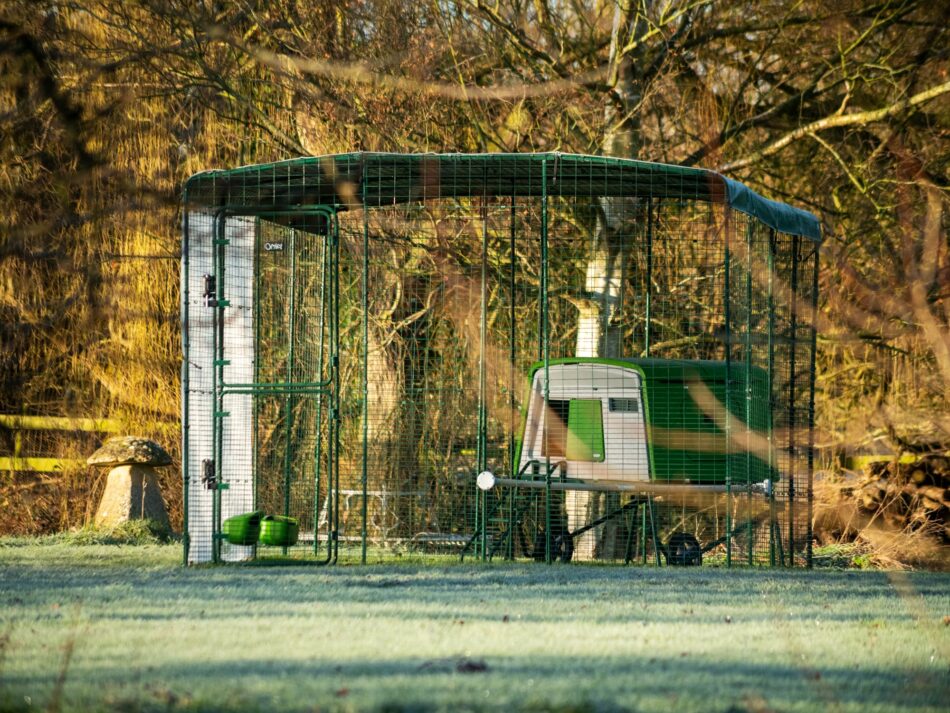
Chicken run covers are an essential part of keeping your flock healthy and happy. They offer shade in summer, act as an umbrella during downpours, and keep debris from falling through the top of the run. In rain or shine, Omlet’s line of chicken run covers offers a wide range of protection for your hens.
What are run covers?
Outdoor chicken run covers are specially crafted tarps that go over the top of a chicken run. They offer shade from the sun, keep rain from falling on your hens, and act as a barrier from falling debris. This is especially important in preventing avian flu in chickens, as the virus is shed through the droppings of birds that fly over your flock.
Our covers differ from traditional tarps in that they are designed to be weatherproof, long-lasting, and specific to each size of our runs. Omlet’s Walk In Chicken Runs have gable-shaped roofs specially designed to support our covers and prevent water from accumulating on them.
Omlet run covers come in two different options: heavy duty and clear. Both are made from UV-resistant, waterproof materials, but our heavy duty covers block more sunlight to offer shade during warm weather. The clear covers are ideal for the wintertime when natural warmth from the sun is in short supply.
Which run cover do I need?
Choosing the right cover for your run depends on your location and chicken coop position. If your coop and run are in a shaded area, then a clear cover for winter months will offer protection and sunlight when shade trees lose their leaves. If your coop and run are out in full sunlight, a heavy duty cover will provide shade and shelter from storms.
Similarly, chicken keepers in warm climates will benefit from heavy duty covers that allow as little sunlight through as possible. This reduces the number of UV rays shining through on your flock, and provides shade from the sun. Colder climate hens will appreciate the additional sunlight that clear covers allow in, while keeping the snow and ice out.
We also offer combination covers that include protection for both cold and warm weather. These can be positioned on top or on the sides of the run to adjust the amount of light allowed in. Positioning a cover down the side of the run also provides a wind break – an attractive option for flocks in windy areas.
Omlet chicken run covers are custom-made for each size run that we offer. From attached Eglu runs to larger walk in runs, we have a cover for every set up. Mix and match your covers if you have your Eglu’s run attached to a walk in run for a wider spectrum of coverage.
What else do I need for my chicken run?
Once your run is covered, accessories can be added for your flock to enjoy in any weather. A PoleTree Customizable Chicken Perch is a great addition to a walk in chicken run, as it offers multiple levels of perching space. The PoleTree is completely customizable to your hens and their space, and can be outfitted with individual and connecting perches, as well as treat dishes. Pendant Peck Toys offer fun at ground level, and keep the run nice and tidy – reducing visits from rodents. A Chicken Swing is another favorite among our customers and their hens, and offers entertainment all around!
Does my run need bedding?
Even with a run cover, your chickens’ run will need bedding of some sort. Unless you have a chicken tractor to move around your yard, your chickens will make quick work of any grass in their run. Without grass, your chickens’ run will turn into a muddy mess in a hurry. A covered run greatly reduces the amount of rain that will make its way into the run, but heavy storms can blow rain in from multiple directions.
The most common choices for the floor of a chicken run are:
- Wood chips
- Sand
- Pine shavings
- Straw
- Gravel
You can use a combination of substrates depending on your soil’s ability to drain. A covered run will keep bedding fresher longer – especially natural flooring media such as shavings or straw.
More weather-resistant products from Omlet
Omlet understands that life is full of extreme variables. We’ve created accessories that enhance our products’ safety and comfort measures. Our sophisticated Eglu Cube Chicken Coop has superior insulation to keep your flock warm in the winter and cool in the summer. But by adding Temperature Protection to our coops, you’ll double down on the insulating properties to keep your chickens comfortable in any climate.
The most rewarding feeling as a chicken keeper is knowing your flock is as comfortable and safe as possible. Omlet creates products that bring chickens and their keepers closer than ever – improving their collective happiness in the process.
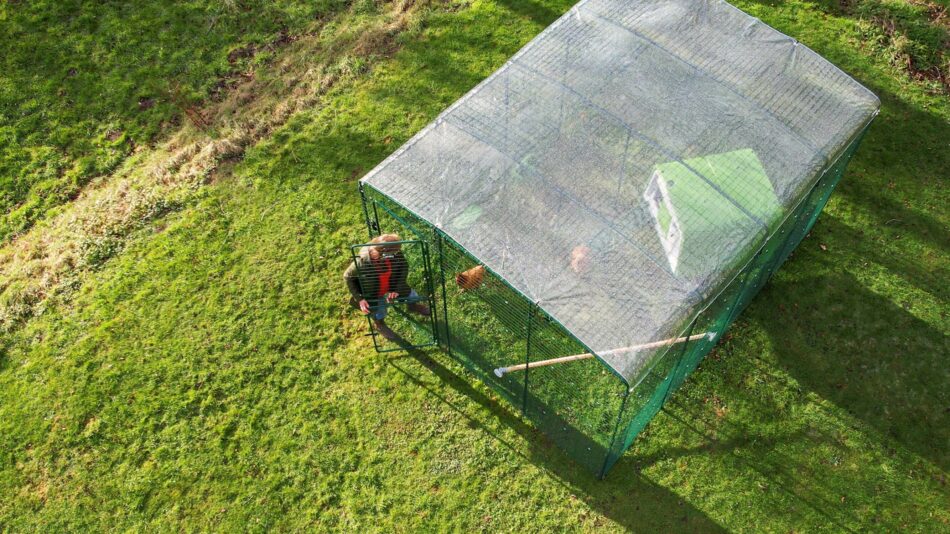
This entry was posted in Chickens
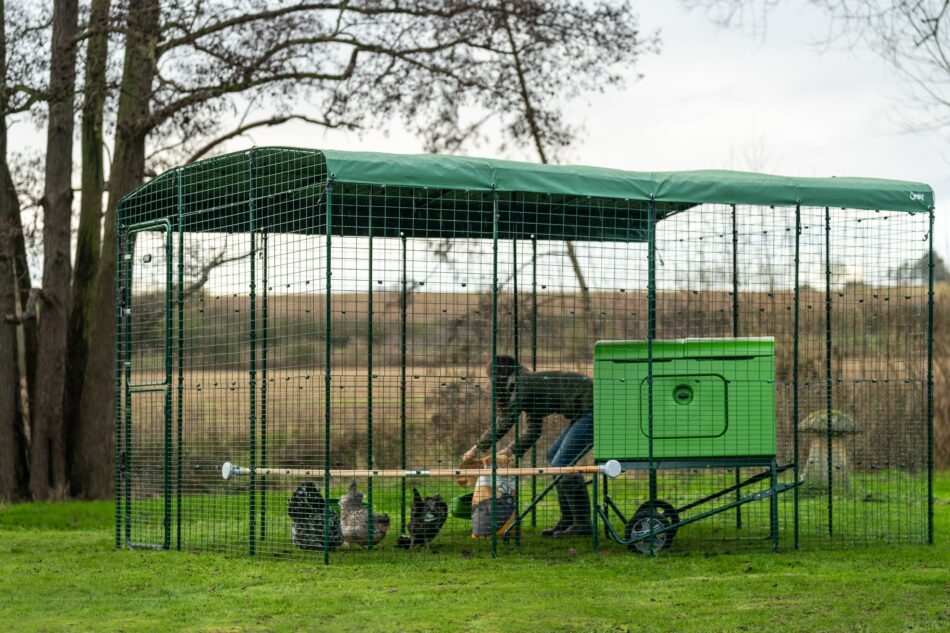
Caring for chickens is a rewarding experience for all ages. While commonly associated with farms and barnyards, chickens are rising in popularity as pets. And why not? Birds of various species are kept as beloved pets, and chickens are part of the avian family.
Chickens make for unique and relatively low-maintenance pets. With the right care, hens can provide a family with fresh eggs all year round. Quality hen housing, food, fresh water, and simple cleaning routines are essential to helping your chickens thrive. But we’re just scratching the surface here – let’s dig into caring for chickens with tools to ensure success for your flock-raising journey.
Are chickens easy to take care of?
As long as your flock’s requirements are met, the rest of their routine is entirely up to you! The basic needs of chickens are:
Chickens don’t require annual vaccinations like other household pets. Deworming can be done on a routine basis, but can usually be accomplished through feeding herbs and other natural anti-parasitic measures. Feed stores also carry deworming agents that can be added to your flock’s feed or water, but be sure to ask your veterinarian before choosing a dewormer.
It’s always a good idea to have a veterinarian that is familiar with chickens lined up before bringing your chickens home. A veterinarian can also be a great resource when deciding on what breeds to get and finding the right breeder.
Hens are social animals with each other, but don’t require daily interaction with humans to thrive. While they’ll certainly enjoy the snacks and treats you bring them, they don’t crave human interaction. But as most chicken keepers will agree, spending time with your hens is a relaxing and enjoyable experience.
Caring for chickens: the essentials
Though they’re hardy and adaptable, chickens still need a helping hand from their keepers to stay safe and comfortable. Chicken essentials should be selected with care, as they are not all created equal in terms of safety, benefits for the keeper, and functionality.
Coops and runs
A coop is an absolute essential when keeping chickens. Chickens naturally seek a place to roost at night, a safe nesting area, and shelter from the elements. A good chicken coop will fulfil all of those needs, but an excellent chicken coop will have added benefits for you as well. Some additional features that will make chicken keeping more enjoyable for you include:
Choosing your chicken coop comes down to personal preference, but be sure to consider all of the benefits before making your final selection. Also take into account what size chicken coop you’ll need. Some breeds of hens get larger than others, so select a chicken coop size that will accommodate your flock comfortably.
Another important component of keeping chickens is a chicken run. Most hen keepers prefer a walk in chicken run so that they can easily spend time with their flock and see to their needs. Omlet’s walk in chicken runs are heavy duty, with roof panels and anti-dig skirting for top to bottom security. It can also be added onto to accommodate growing flocks.
Food and water
As chickens tend to pick through their food, offering their feed in covered chicken feeders will help reduce waste. Chickens can have their pellets left out free-choice, and are not in danger of overeating. Be sure to check their feed levels regularly and top off as needed.
Scratch grains or fresh chicken-safe produce can be fed in chicken treat dispensers to add nutritious variety to your flock’s diet. These treats should be offered as a supplement to laying feed, and are helpful when bonding or working with your hens. Some chickens are very food-motivated!
Fresh, clean water should always be available to your flock. Skim any debris from your chickens’ water if needed, and replace their water every 2 or 3 days to maintain freshness. In the warmer months, chicken-specific electrolytes can be added to keep your hens hydrated.
Entertaining the flock
Chickens are curious by nature, and love to explore, which makes them very enjoyable to observe. Being the inquisitive characters they are, they will seek out entertainment opportunities, and can quickly become bored without enough engagement from their surroundings. Bored chickens can turn to undesirable behaviours such as pecking (themselves or each other), aggression, and can even become listless or lethargic. In short: a bored hen is not a happy (or healthy) hen!
There are several features that can be added to your flock’s run to encourage their natural tendencies and exercise both their minds and bodies. Some accessories that will enrich your run include:
By creating an environment that fosters your flock’s natural behaviours, you can keep them safe and happy inside their run full-time. Plus, there’s nothing quite like watching your hens relax on their swing or explore the height of their run on their perches.
Protection against predators
Even if you live in an urban setting, chicken predators can be abundant. It’s important to have a predator-resistant chicken coop and run, complete with anti-dig skirting to help keep predators at bay. As an added layer of protection, an automatic chicken coop door can be added to your hens’ house to ensure they’re enclosed every evening – even when you aren’t home. Omlet’s Autodoor offers additional protection in the form of a horizontal closing mechanism, making prying the door open nearly impossible for predators.
Keeping hens healthy
Daily check-ins with your flock are essential for staying on top of their health. A healthy chicken is bright, alert, and responsive, with no visible or audible issues. Quickly checking in with your hens will usually be enough to notice if something is amiss with them. Many illnesses that occur in flocks can be treated, so it’s important to quickly relay concerning symptoms to your veterinarian.
Avian flu is on the minds of lots of chicken keepers, but can largely be prevented with a few modifications to your chicken run. Covering your flock’s outdoor space with a waterproof tarp is one of the best preventative measures to take. Ask anyone who has their own birds at home (of any species) not to go in with your chickens. This is helpful in preventing not only avian flu, but other bird-borne illnesses as well.
What to know when keeping baby chicks
Chicks require special considerations apart from adult hens. They need a heat source in the form of a heat lamp or brooder plate to simulate the warmth they would receive from their mothers after hatching. They also need to be kept in a special enclosure, usually referred to as a brooder, for several weeks with their heat source before being introduced to a coop and run.
Things to consider when raising chicks:
- They’ll need to stay in a brooder enclosure with a heat source for 6-12 weeks
- Feeding is required daily, as growing chicks eat much more often than adult hens
- Shallow waterers, changed daily (chicks are messy!)
- Daily monitoring and adjustment of heat source to ensure proper growth and development
- Slow introduction over time to their outdoor environment
Raising chicks is a big commitment, but can be very rewarding. Chicks that are handled daily by their owners tend to be tamer once they’re placed in their permanent homes.
Caring for your chickens through the seasons
You’ll need to provide supplemental care for your flock during certain seasons. This is largely dependent on where you live, but winter and summer considerations are universal for most chicken keepers. Line out chicken keeping challenges throughout the year and create a plan according to your climate to successfully help your hens through each season.
Winter
Winter can be an enjoyable time for your chickens, so long as you help them prepare and weather the cold. Hens usually do better in colder temperatures than in intense heat, but some parts of the country experience frigid temperatures that require a helping hand from their humans. You’ll want to make sure that your chickens’ coop is well insulated, and potentially add winter weather coop protection if needed. Waterproof chicken run covers help keep snow and ice out of the run, and chicken perches give frosty feet a respite from the cold ground. Offer supplemental chicken treats and feed to help increase their metabolism, and place chicken toys around the run to keep your hens healthy and active during the cooler months.
Spring
Spring is a favourite season for both flocks and their keepers. The temperature is moderate, and there’s more sunlight for your hens to bask in. Insects and vegetation are abundant, and your chickens will be eager to seize the warmer, longer days. Hens lay more eggs in the spring than any other season, and may also attempt to go “broody” (sit on a clutch of eggs) this time of year. Collect eggs daily to discourage broody hens from sitting and to help maintain egg production.
Summer
Depending on your location, summer may be the most difficult season for your flock. It’s vital to help keep your chickens cool in the summer, as hens can overheat quickly. Be sure to keep fresh, cool water available at all times, adding chicken-specific electrolytes if needed. Offer frozen treats to your flock, or make your own summer chicken treats to help your hens stay cool. Shade will also be a hen’s best friend in the summer – chicken run covers can help shield them from harmful UV rays and alleviate some stress from the heat. Monitor your flock for any signs of heatstroke, and bring overheated chickens inside promptly.
Autumn
Autumn is another favourite season for flocks. Fallen leaves make excellent scratching grounds, and the cooler weather offers respite from the summer heat. Chicken keepers prepare for autumn in a variety of ways, depending on their location, but helping your hens through a moult is common when the days grow shorter. There’s also an increased risk of avian flu during the autumn, as migratory birds begin their journey across the country.
What to avoid when caring for chickens
There are a few things you will want to avoid when caring for chickens. Thankfully, this list is relatively short, as chickens are generally low-maintenance and resilient pets.
- Research chicken breeds before deciding on which type of hens you want to keep. Make sure you’re familiar with temperaments, egg production, and lifespan of the breeds you’ve settled on.
- Get the biggest coop and run setup that your budget allows for from the beginning. A flock can never have too much space, but they will certainly find themselves unhappy in too little space.
- Be sure to have a support system when getting chickens for the first time. A veterinarian, flock-keeping friends, and expert advice goes a long way in encouraging you throughout your journey with chickens.
Omlet’s here to help
Keeping chickens should be as enjoyable as keeping any other pet. We love that chickens are making the transition from barnyards to gardens, and our products are designed to help keep hens healthy and happy in any setting. From hen houses to chicken fencing, we’ve got everything you need to make your chicken-keeping journey a success.
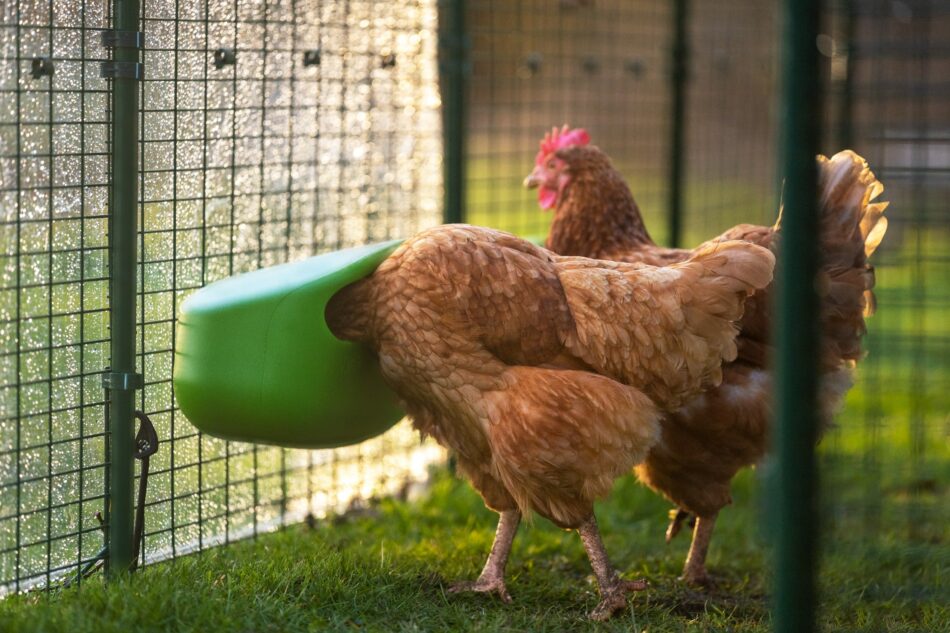
This entry was posted in Chickens
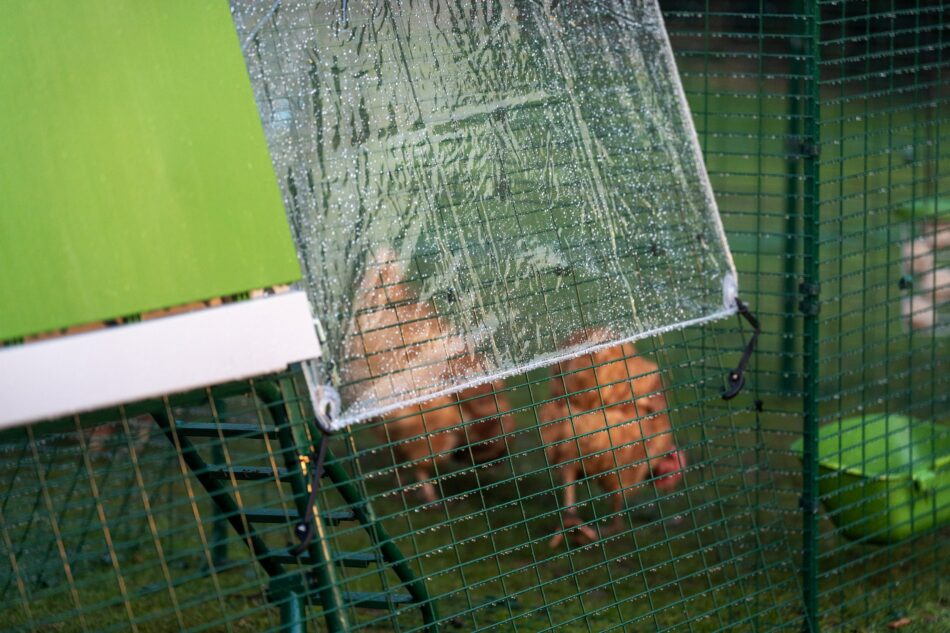
Have you ever wondered if your chickens like the rain? Hens don’t put on rain hats and boots to weather a spring shower, but some chickens are more willing to stay out in the precipitation than others. Whether it be rain showers or all-out downpours, at some point all chicken keepers will have to help their hens through wet weather. Thankfully, Omlet has the products that keep chickens safe – whatever the weather.
Rain and chicken safety
You may have some hens that are more than happy to hang out in a rain shower, or peck through the puddles in the aftermath. But, some chickens may avoid precipitation at all costs. As a general rule, hens will seek shelter once a sprinkle becomes more of a drenching experience than an enjoyable shower.
Rain isn’t necessarily dangerous for your hens so long as the temperatures are moderate. The most dangerous time for a chicken to become wet is during cold weather, as hens need to be able to fluff their feathers up to trap air around their bodies as insulation. If they’re wet, feathers will be heavy and lay flat, which keeps a hen’s feathers from doing their job.
Our new Walk In Chicken Run Rain Covers encompass the entire top of your flock’s run with a waterproof barrier to help keep the rain and snow out. No walk in run? No problem – our new Eglu Go Up Rain Covers will keep attached runs free from moisture as well. Keeping precipitation from falling directly on your hens is the best way to help them stay warm and dry.
Other dangers of rain for chickens
Aside from rain during cold weather, too much moisture can spell other trouble for chickens. Muddy conditions in the run opens your flock’s feet to bacteria and fungal infections, and creates unsanitary conditions. And, hens that stay wet or in damp houses for extended periods of time can develop upper respiratory infections. These primarily develop from mould or mildew growing in their coop, which is why a chicken coop that will not absorb moisture is so important to your hens’ health.
Puddles may be fun for kids to splash in, but chickens may drink from rainwater that has collected on the floor of their run. Muddy puddles can contain harmful bacteria and are not ideal for your flock to drink from. In addition to waterproof chicken run covers, bedding should be added to the floor of any runs that don’t have enough grass to prevent the ground from becoming excessively muddy.
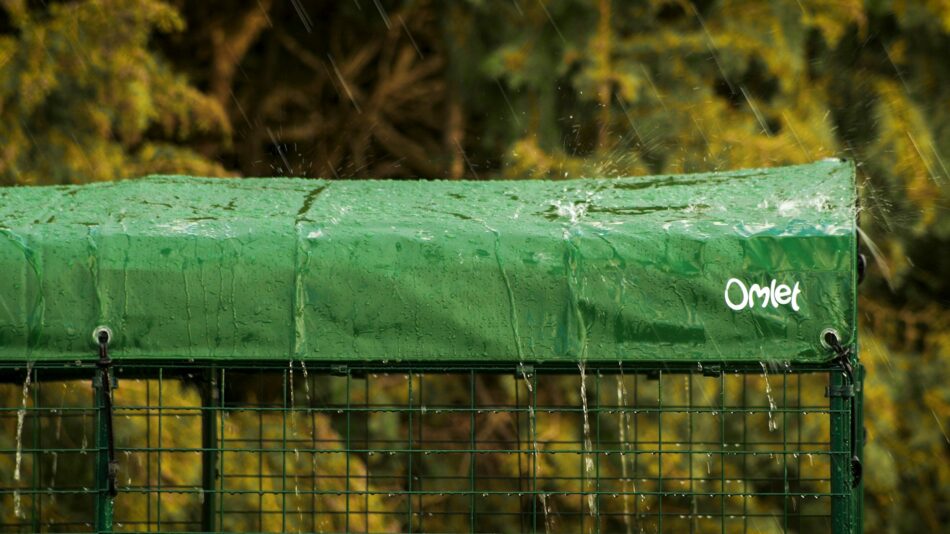
Do any chicken breeds like the rain?
Some breeds of chickens struggle more than others in damp weather. For example, Silkie chickens have special feathers that do not repel water, so they can quickly become soaked through to their skin. Polish chickens are another breed that does not do well in wet weather, as they have loosely grouped feathers that do not keep them dry. Other breeds, such as Rhode Island Reds have tightly grouped feathers that help repel rainwater. Other hardy breeds such as Plymouth Rocks and Australorps have better tolerance in extreme temperatures, making them more resilient in damp conditions.
Are chicken feathers waterproof?
A chicken’s feathers are weather resistant, but not weatherproof. The tighter the feather grouping, the more weather resistant a hen’s plumage is. Once even tightly grouped feathers become saturated, water begins to seep through to a hen’s skin and there it begins to affect body temperature. Wet feathers are heavy, so chickens can’t fully fluff themselves in order to dry off once their skin becomes wet. In the wintertime, this can quickly lead to hypothermia. Being a wet hen in summer months is more of a nuisance than a danger, but can still lead to discomfort.
Most hens are aware of their limitations, and you’ll see most head for shelter when they feel they are getting too saturated. However, sometimes hens get caught out in a downpour. If the weather is below 60℉, bring soggy hens inside and towel them dry, being careful to move in the direction of their feathers. Wait for them to dry fully before letting them back outside.
How to keep your flock protected
Our new Eglu Go Up rain covers come in different length options to offer full top-to-bottom coverage, or a ⅔ length to allow a breeze through the bottom third of the run. The walk in chicken run covers now offer full-length coverage in a variety of sizes to fit across the entire top of the run. Continuous coverage means no gaps, dripping, or seams for the wind to grab.
Just like our run covers, Omlet’s chicken products are designed to perform and protect. Going above and beyond their intended purpose, our Eglu Cube has withstood much more than rain! That sort of performance is what we expect from all of the products we invent.
Omlet and your chickens’ home
We strive to create top-quality products that keep your chickens safe and make caring for them enjoyable. Our line of chicken coops are designed to withstand the elements, weather, and anything else life throws at them. Combine our resilient coops with a heavy duty walk in chicken run maximum protection and comfort for your flock – and peace of mind for you.
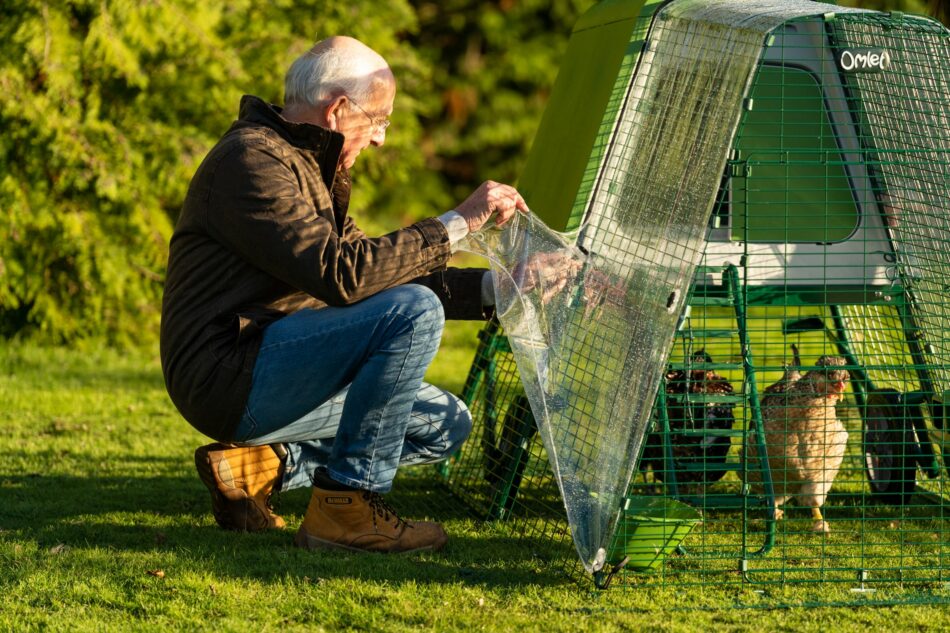
This entry was posted in Chickens
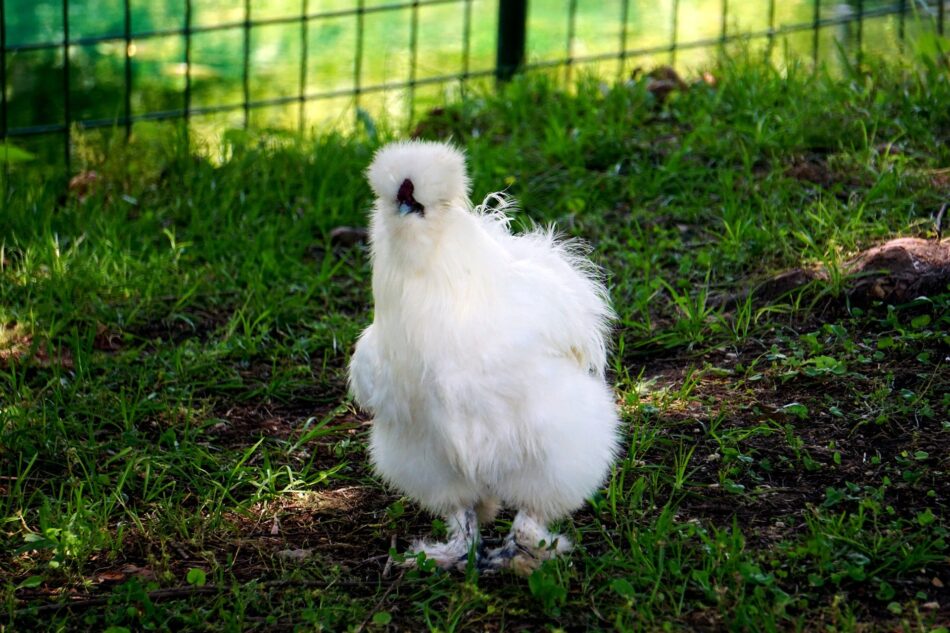
Caring for Silkie chickens is a little different than caring for their regular-feathered counterparts. This breed of chicken, with its very distinctive appearance, has gained popularity among flock raisers everywhere. They’re fluffy, friendly, and fun to watch and interact with. And due to their mild temperaments, are known to be great for children.
Silkie chickens come in a variety of colors, and their fuzzy plumage resembles fur more than feathers. In fact, ancient history describes them as “chickens with hair like a cat.” This ornamental breed isn’t known for egg production, but will lay a modest amount of small eggs per year.
Origin of Silkie chickens
The exact origin of Silkies is unknown, but experts believe they originated somewhere in Asia. Marco Polo described “furry chickens” in his journal during an excursion through China in the 13th century. Some time later, Dutch breeders of Silkies marketed them as a cross between a chicken and a rabbit.
A Silkie is actually a type of “Bantam” chicken. Bantams are a breed of chicken that are much smaller than standard chicken breeds. Other types of Bantams include:
As Marco Polo noted, Silkie feathers have a fur-like appearance. They appear furry rather than feathery as a result of genetics. Chickens with normal feathers have microscopic hooklets that connect each fiber (called “barbs”) on their feathers, creating a rigid and smooth appearance. Silkies have a genetic mutation that creates an absence of these hooklets. Because they lack this feature, a Silkie’s barbs are free to flow every which way, giving them their unique, fluffy appearance.
Are Silkie chickens higher maintenance than other chicken breeds?
While the fluffy appearance of Silkies is adorable, it does pose an issue when it comes to hardiness. Since their feathers are not rigid, Silkies do not have any sort of moisture barrier. Once wet, they will be saturated right down to their skin. This creates very dangerous conditions for any chicken – particularly in cold weather.
Caring for Silkie Chicken in Winter
Chicken coops with double-wall insulation are essential to keeping Silkies healthy and happy. Weatherproof chicken run covers are also a must-have when caring for Silkies to ensure they stay dry while spending time outside of their coop. As long as Silkies are kept dry in cold weather, they will handle cooler temperatures as well as any other breed. However, when their fluffy, down-like feathers become wet, it will take a Silkie a long time to dry, as they cannot lift their non-rigid feathers away from their skin. A wet Silkie should be placed in a warm coop right away.
Caring for Silkies in hot weather
Silkies also struggle more in the heat than other breeds. This is due to their dense plumage and reduced eyesight from their walnut-shaped comb and feathers around their face. Poorer eyesight makes finding shade and water more difficult. Place multiple chicken waterers around the run to help your Silkies in warmer weather, and provide plenty of shade in their run to help your hens through a hot summer.
How to groom Silkie chickens
While it may be tempting to groom your Silkie, their fluff still consists of feathers – not fur. They will preen and dust bathe themselves just as any other hen would, so extra grooming is usually not necessary. If your Silkie gets extremely muddy, a gentle bath during warmer weather followed by a pat down from a towel will have them looking fresh in no time. If you want an enjoyable bonding activity, you can gently remove bedding or other loose debris from your Silkie using a soft-bristled brush. A baby brush or toothbrush are gentle enough for your hens’ feathers.
Characteristics of silkie chickens
Along with fur-inspired feathers, there are other signature characteristics that every well-bred Silkie should have. While some traits might not be as obvious as their poofy plumage, they all culminate to make Silkies unique among chicken breeds.
Flightless
Due to the lack of “hooklets”, Silkie feathers are not rigid enough to accomplish flight. This makes them ideal backyard birds that will not test fences. Since they can’t fly, chicken perches should be placed at appropriate heights for Silkies to hop on (and off!) safely.
Black skin
Most chickens have white or yellow skin under their plumage, but Silkies have black skin. Even their bones and organs have a black tint to them! This is due to a genetic mutation called fibromelanosis, which causes hyperpigmentation of connective tissue cells. Another chicken breed that shares this trait is the Ayam Cemani, which appears pitch black from head to feather to toe. Unlike this distant cousin, Silkies come in a variety of colors.
Walnut-shaped combs
Silkies have walnut-shaped, slightly lumpy-looking combs that do not extend beyond the feathery tufts on top of their heads. Some combs may hardly be visible at all. Combs should be dark in appearance, just as the rest of their skin.
Stunning blue earlobes
Silkies have bright blue earlobes that contrast starkly with their dark skin and fluffy plumage. In popular folklore, it’s believed that a chicken’s earlobes reflect what color eggs they will lay. For example, a hen with white earlobes will lay white eggs, red earlobes lay brown eggs, etc. This method is somewhat accurate, but some hens with red earlobes also lay olive or blue eggs, depending on their genetics. Silkies however lay white or cream-colored eggs – despite their colorful lobes.
Extra toes
Yes, you counted right – Silkies have 5 (sometimes 6) toes on each foot. This extra toe (or two) appears along with the “hallux” at the back of the foot, and does not touch the ground. These extra appendages don’t offer any practical value, other than adding to the cute quirkiness of the Silkie breed. There are only 5 chicken breeds known to have 5 or more toes on each foot.
Ornamental vs. layers
Silkies are not prolific egg layers, averaging 2-4 eggs per week. This classifies them as an “ornamental breed” of chicken, which are known more for their looks and personalities than their egg production. Still, they produce small white or cream-colored eggs to gather. Like other Bantam breeds, the ratio of egg yolk to white is larger in Silkie eggs than in standard chicken breeds.
Mild temperament
Silkies are well known for their calm, friendly personalities. They are great first time pets for children, offering both visual appeal and docile temperaments. Since they can’t fly, they’re easy for children or first-time chicken keepers to handle and interact with, and often enjoy being held.
Varieties of silkie chickens
Silkies come in a variety of colors, including: buff, black, white, and blue. There are also patterned variations such as “splash” Silkies, which are a mixture of colors. In addition to color, Silkies are now bred for different textures. For example, you can now own “Frizzle” Silkies, whose fluffy feathers have a crimped appearance! Other varieties to emerge include “Silkie Showgirl”, which is a cross between a Silkie and a Turken (Naked Neck) chicken. The result is rather shocking: a signature Silkie “pom pom” on the head, a completely featherless neck, and a fluffy body.
Variation in Silkies does not affect the overall integrity of the breed, as each color and variation are still bred to be docile pets with unique appearances. The Showgirl and Frizzle varieties are not officially recognized by Silkie breed standards currently, and are harder to find than traditional Silkies.
Can silkie chickens live with other breeds?
Can different chicken breeds get along? That depends. In general, hens get along as a flock once they’ve established their pecking order. Roosters are more likely to fight and cause a ruckus, but some hens can also be pushy and dominant. If you’re considering adding Silkies to an existing flock of larger chickens, take each of your hens’ personalities into account. If you have an overbearing, dominant hen, it may be best to keep your Silkies in a separate area. If you have a walk in chicken run, consider adding partitions to separate hens according to size or level of dominance.
Hens of similar size can usually be housed safely together. Silkies are passive by nature, and will be at the bottom of a flock’s pecking order. Larger hens may accidentally injure Silkies while establishing this hierarchy, simply by being bigger in stature.
Omlet and silkie chickens
Silkies, just like any other breed, benefit from enriching chicken toys, a safe and solid hen house, and high-quality diet to live their best life. Omlet’s wide selection of expertly designed chicken coops, runs, and accessories will help you raise a thriving flock of Silkies. But if Silkies aren’t the breed for you, there are many other breeds of chickens to choose from, all offering their own unique characteristics to bring luster to your life.
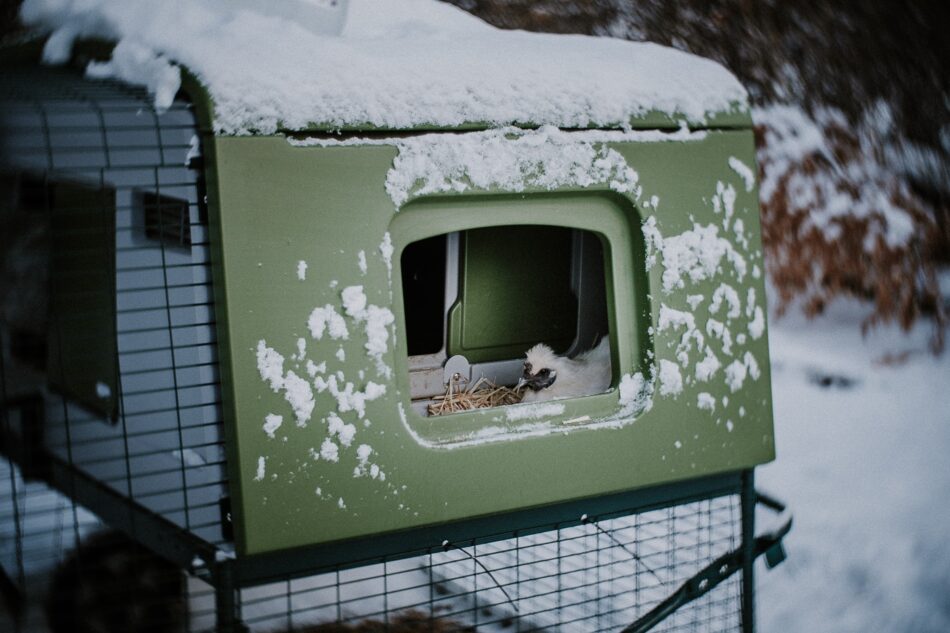
This entry was posted in Chickens
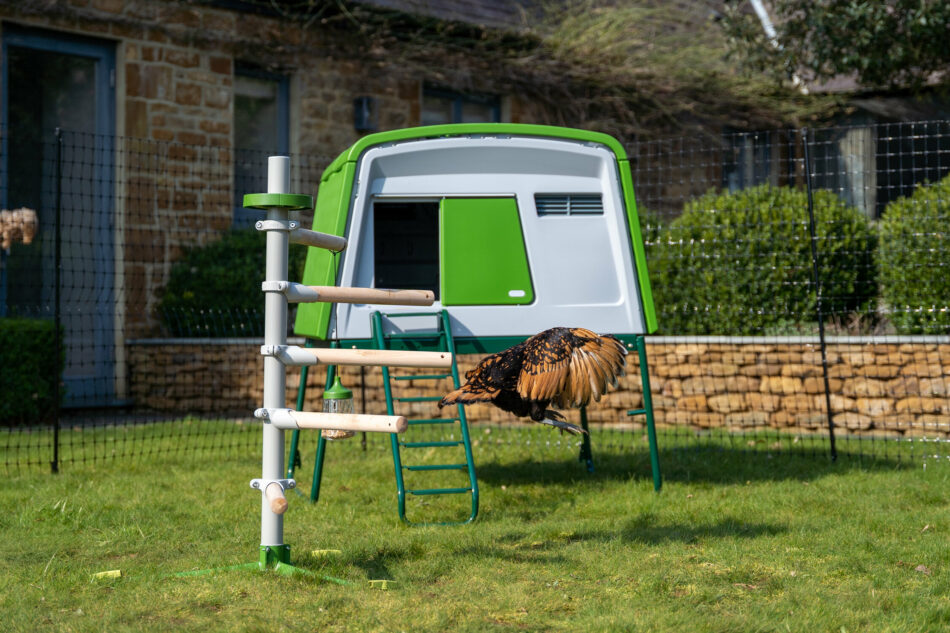
Did you know that you can keep chickens in the city? It’s true – you can have your own slice of farm life right in your garden. There are a few special considerations when caring for chickens in an urban setting, but with a solid strategy and quality flock essentials, you’ll be able to enjoy fresh eggs and the unique experience of owning chickens.
Regulations
In the UK, there are almost no laws that will stop the average chicken keeper from having a few birds in their back garden. That being said, there are a few things that are worth bearing in mind, which you can read about on our UK chicken-keeping rules and regulations page.
Do you have enough time to raise chickens?
After you’ve gotten permission or verified there are no restrictions for having chickens in your garden, it’s time to make a plan! First and foremost, you’ll need to evaluate how much time you have to dedicate to a garden flock. Will you be home daily to collect eggs and check in on your chickens? Do you travel a lot? Would someone be willing to tend to your flock in your absence?
As far as pets go, chickens are relatively low-maintenance. Chickens don’t require daily interaction from their humans like other pets, but they do need basic provisions. If they have a secure chicken coop and run, their food can be left out and refilled as needed, along with their water. An easy-to-clean chicken coop is a huge time-saver when it comes to refreshing your hens’ home. Chicken coops in the city should be cleaned daily to minimize the presence of odours and insects.
Laying hens should have their eggs collected daily if possible to prevent attracting nest-thieving predators. When collecting eggs, take the time to do a brief check-in with your hens to make sure everyone is healthy and happy. Inspecting your hens’ eggs can also give you a good idea of their overall health.
You’ll need to have a reliable chicken-sitter for when you go out of town. Most people from the city would love the opportunity to care for chickens, but may be unfamiliar with hens. Provide detailed instructions and allow ample time for your chicken sitter to come by and watch how you tend to your flock before leaving.
Consideration for neighbours
Once you’ve determined how and where you can house your hens, and decided that the time commitment fits with your lifestyle, it’s time to prepare your garden for your flock. Do you want a mobile chicken coop that can be repositioned, or the more permanent placement of a coop with a walk in run chicken run?
Keep in mind that while chickens themselves have little to no odour to the human nose, their droppings do. Be considerate when choosing the location of your chickens’ coop – toward both yourself and your neighbours. Daily coop cleanings will cut down on smells and the presence of flies, but you should place your hens’ house an appropriate distance from human dwellings.
Most hens won’t make much noise, but they can stir up a ruckus when something is amiss in their surroundings, or when they have laid an egg. The majority of chicken sounds and their meanings are quiet daily interactions with each other and their surroundings. However, some hens are capable of making noises that may come across as other-worldly to your neighbours, so it’s a good idea to explain your new garden inhabitants to them ahead of time! And, even if you’re not restricted from owning roosters, be aware that they crow at all hours – not just at dawn. In fact, many roosters will crow in the middle of the night. If you’re in close proximity to neighbouring houses, it’s best to forgo owning a rooster.
Urban predators
Urban settings are not immune to the presence of predators that have a taste for chickens. Urban predators include:
- Rats
- Badgers
- Foxes
- Neighbourhood cats or dogs
The Eglu Cube Chicken Coop is a predator-resistant option for garden flock keepers. The unique coop door mechanism makes it difficult for animals to pry open during the night, and the locking egg access and rear doors help keep unwanted visitors out.
An Omlet Walk In Chicken Run provides safety measures from the ground up. Anti-dig skirting comes standard on all Omlet chicken runs to help prevent tunnelling in from the outside, and mesh roof panels keep aerial predators at bay.
If your space doesn’t allow for a walk in run, an automatic chicken coop door can be installed on your Eglu Cube or other chicken coop to ensure your hens are tucked away safely each night. Not only can you automate your chickens’ schedule with the Autodoor, but you can add an additional layer of security between your flock and potential threats. The Autodoor opens horizontally on a spiralling metal mechanism, making it extremely difficult for animals to pry open.
Noise of the city
Your chickens may be temporarily upset by the noises created by traffic or pedestrians. Since chickens are adaptable, they’ll grow accustomed to the noise over time, but if possible position your chickens’ coop behind a good sound barrier. This could be your home, a privacy fence, or another solid structure.
If you’re introducing farm-raised hens to an urban setting, the transition may be more stressful than chicks raised in your environment. Consider placing chicken run covers on the sides of your flock’s run to give them a reprieve from visual stimulation while they process the noises of their new surroundings.
How Omlet can support city chicken keeping
Chickens are happy just about anywhere, but at Omlet, we want them to be able to foster their natural behaviours no matter where they live. All of our chicken products are designed to enrich your flock’s environment – no matter how big or small. Chicken peck toys, the Freestanding Chicken Perch and Chicken Swing are just some of the products we’ve invented to keep your hens healthy and happy in their home. With a chicken coop and run to fit any size garden, you’ll find that our expertly designed products will ensure success when keeping chickens in the city.
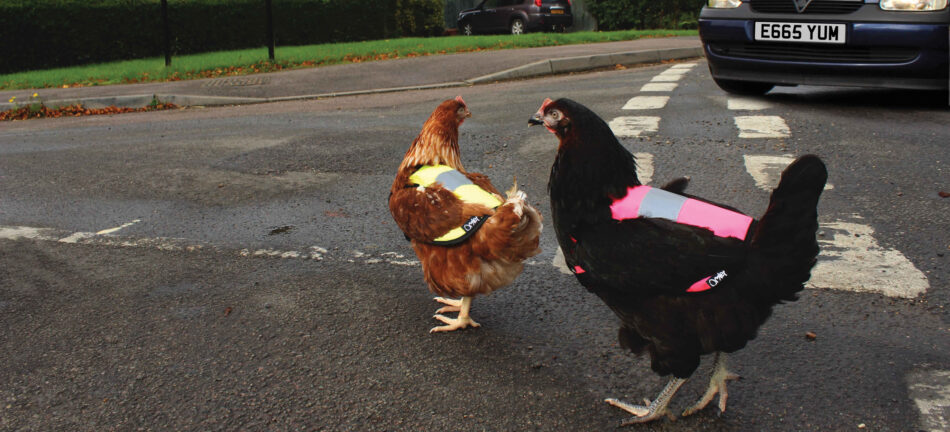
This entry was posted in Chickens
Are you in need of chicken coop ideas? Maybe you’ve thought about building a DIY chicken coop. Or, maybe you need inspiration to spruce up an existing hen house. You’ve seen pictures of cute chicken coops and runs all over the internet, but may still be wondering how to get your chickens’ area to that level. There’s a fine line between Instagram-worthy and functional chicken setups, but with careful designing and crafting, you can have your coop and enjoy it too!
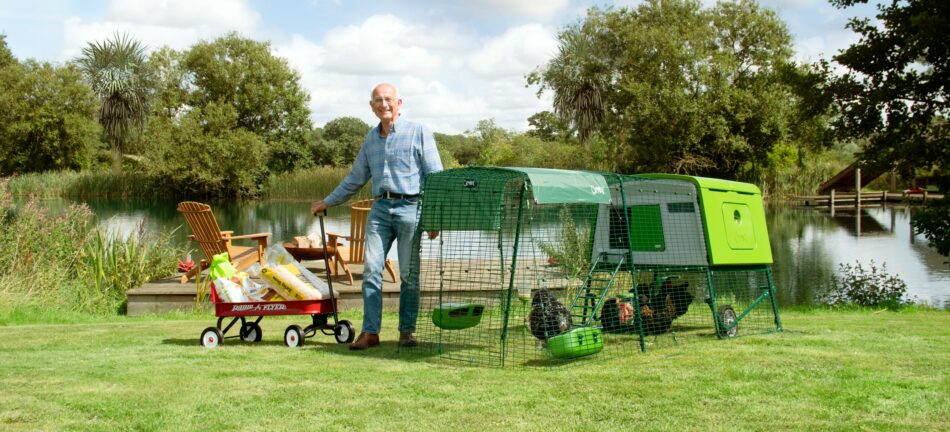
Ideas to consider for your chicken coop
Chicken coops are as diverse as the chickens they house – they come in all shapes, sizes, price points, and ratings. As a chicken keeper, the options to customize your hens’ space can be overwhelming. But, just as it is with your own home, as long as your chicken coop has “good bones” the rest is simply a matter of personal preference.
All hen houses should be both practical and enjoyable for chickens and their keepers. Otherwise, keeping chickens becomes a chore rather than a joy. By customizing some easy chicken coop ideas, you’ll be able to create the ideal space for both you and your flock. So without further ado, let’s dive into some chicken coop inspiration to help get those creative gears turning.
Essentials to consider before building a chicken coop
Before acting on your chicken coop ideas, be sure to contact your city offices (if you live within city limits), homeowners association, or other authorities that your property may be subject to. Many cities allow chickens to be kept in residential backyards, but may have chicken zoning laws. Rules pertaining to chicken keeping may prohibit keeping roosters, have flock size limits, and have requirements for how far chicken coops need to be from your neighbors. Some cities or associations may also require permits for permanent structures, or specify that chicken coops must be non-permanent fixtures. Once you’ve got permission from your governing authority, proceed with planning your chickens’ coop ideas.
Omlet chicken coop inspiration
Our designs for chicken coops were inspired, and hopefully they’ll inspire you on your journey to be a chicken keeper. The superior ventilation and insulation, cleanability, flexibility, and customization options make our chicken coops the absolute best way to keep your hens healthy and happy. Omlet chicken coops:
- Are draft-free, while providing ample ventilation
- Use insulating methods to keep the interior of the coop as comfortable as possible in all weather
- Are easy to clean, sanitize, and maintain
- Have predator-resistant features like heavy-duty materials, anti-dig skirting around the run, and secure coop doors
- Give the option to make any of our coops mobile with the addition of wheels and handles
- Have fully customizable chicken run accessories and sizes
- Are easy-to-build chicken coops
- Come with coordinating chicken feeders and waterers
- Have everything you need to start keeping chickens right away
When you choose an Omlet chicken coop, you’ll have everything you need to keep hens successfully and safely. We’ve designed all of our chicken products to delight chicken keepers in all walks of life – the seasoned chicken owners to complete beginners.
6 chicken coop ideas for inspiration
Like many great projects, sometimes getting started on your chicken coop can be the hardest part. We’ve compiled the most common and important considerations when designing your chickens’ space. So whether you’re short on inspiration, or needing to fine-tune some ideas for your chicken coop, give your creativity a springboard with these ideas.
Should I DIY my chicken coop?
There are hundreds of designs online for DIY chicken coop plans, or ones that can be purchased to construct a hen house from scratch. If you have a flair for design, the DIY approach may appeal to you. If you aren’t intimidated by designing, purchasing, and constructing everything needed for a chicken coop that is. But here’s the catch: unless you’re a structural engineer or an architect, sometimes even the most well-meaning designs leave much to be desired.
Since DIY designs are not quality tested, it’s important to remember that no matter how picture-perfect a chicken coop appears, it must also be functional. Chickens have housing requirements that are crucial to their health and well-being that any DIY design must keep in mind. When deciding to build or buy a chicken coop, be sure to account for adequate ventilation, space, insulation, and health concerns like mite and waste control.
Some DIY chicken coops suggest using low-cost materials such as pallets or plastic barrels, but use caution when constructing a hen house from these. Pallets hold all sorts of cargo, and being made of wood, they absorb whatever may have been spilled on them. Likewise, plastic barrels could potentially have held liquids or materials hazardous to chickens. It’s best to purchase new materials when constructing a DIY chicken coop.
Plastic vs wooden chicken coops
There are actually several different types of chicken coops if you choose to purchase your hens’ home. Most commercially purchased chicken coops are made of various types of wood. Smaller, modestly priced chicken coops are usually made from untreated, thin wood. While these may be attractive to the eye (and budget!), many of these chicken coops don’t last longer than a year or two, and require regular maintenance. Thick, weather-treated lumber holds up much longer in the elements, and metal roofs instead of shingle require less upkeep. The weather will cause painted wood to peel, chip, and fade, so be prepared to apply extra coats of paint when needed. Wooden coops are also known for being habitats for mites, so regular application of a chicken-safe pesticide is necessary to break mite life cycles.
Plastic chicken coops are an alternative to wood. These require much less maintenance, and don’t rot from moisture or sunlight. And, while wooden coops can be pressure washed/hosed out, they take several hours to dry. The benefits of a plastic chicken coop include:
- Plastic chicken coops can be sprayed down in minutes and wiped dry with a towel, making them much easier to keep clean
- Plastic chicken coops are much easier to move if needed, as wooden coops are held together by wood screws or tongue and groove planks that must be kept level at all times.
- Unlike wood, plastic is not an ideal environment for mites, so regular cleanings are all that are needed to keep parasites from pestering your hens.
Permanent vs. mobile chicken coops
You may have a specific place in mind for your backyard chicken coop, or maybe the perfect spot on your property. But what happens if you decide to move one day? Or, maybe your permanent chicken coop is no longer in line with the vision for your property. Mobile chicken coops are excellent options for flock-keepers of all sizes and locations.
Permanent chicken coops are easier to design, as weight and moving parts aren’t factors. These coops are often more secure with heavy, sturdier materials, making it difficult for weather or predators to disturb them. However, there are special considerations for chicken coops of a permanent nature. Materials can add up quickly when designing permanent chicken coop ideas. Do you need to have a concrete slab poured for the floor? Will you need a permit to build a permanent structure? All of these expenses, plus general costs of maintaining a chicken coop should be considered before deciding on a permanent chicken coop.
You should also be mindful of the location of trees or vegetation with deep roots that could potentially fall or grow into or under your coop. Having an immovable coop is a big commitment, and future yard or property plans may be impacted by the location of your chickens’ coop.
Mobile chicken coops oftentimes have attached chicken runs to make them an all-in-one chicken-keeping solution – particularly for small flock-raisers. Wheels and handles allow you to move a mobile chicken coop (also known as a chicken tractor) around your yard or property as needed. Chicken tractors can be found in a variety of shapes and sizes, but typically mobile coops are best for flocks of 10 hens or less.
Run considerations
Chicken runs and coops go together like chickens and eggs! Most of the time, they’re a package deal. In some scenarios (like with free-ranging flocks), you may not need a run for your flock. However, the vast majority of chicken keepers would agree that a run is essential to any setup.
Many commercially purchased chicken coops have small attached runs. This is where size gets tricky… Chicken math is a little complicated, since they need (and benefit) from less space in the coop to roost, and more space out in their run. When it comes to chicken run size, bigger is always better. Hens will always appreciate extra space to play and peck.
Runs attached to permanent chicken coops need upkeep, as hens will graze the same areas until no vegetation remains. Straw or other bedding will need to be added routinely to reduce mud and bacteria. Mobile chicken coops with attached runs can be moved to fresh grass when their area has been thoroughly pecked-over, but may still need bedding during dry or cold seasons.
Get creative with your chicken coop ideas
Chickens are like living art, and their coops can be a gorgeous landscaping opportunity. You can house flashy hens in a flashy setup, or keep solid-colored chickens in minimalistic surroundings. Part of the fun of chicken keeping is setting up their environment – both for them, and for you.
Get creative with the enrichment you provide for your hens. Build them a place for dust baths and research different dust bath “recipes” for your hens. Create multiple perching levels for hens to view their world from. Plant chicken-safe herbs and plants along the sides of the run to add both visual appeal and snacking potential. Buy or make coordinating bins to keep your hens’ food and bedding in. Add treat-dispensing chicken toys or a chicken swing for even more fun.
Maybe metal art would complement your chickens’ coop. Or maybe your chickens are the focal point of your setup and the “less is more” approach is better for your yard. The bottom line is: your chicken coop is a space for both you and your chickens to play and enjoy yourselves, so make it your own.
Ideal size for your chicken coop
Before getting started with any chicken coop plans, you’ll need to decide how many hens you plan to house. This of course can increase over time (chickens are like potato chips – you can’t just have one…or a few), but getting an idea of your starting flock size will help determine what size chicken coop to start out with. Most chicken coops are rated to house average-sized hens.
So what is an “average” size chicken? There are all kinds of chicken breeds, but breeds that are considered to be standard for laying hens are:
Most standard breed laying hens weigh between 3 and 5lbs. Smaller breeds such as Bantams could have less space, but you should still aim to provide as much room as possible. Larger breeds such as Brahmas or Jersey Giants need twice the space that their smaller cousins require.
If you’re not sure what size hens you want to keep, or want a mixed flock, it’s always best to provide as much room as possible. But, if space is an issue, start with a chicken coop and run that has the option to add on and grow your flock along with their space. Expandable chicken runs are an excellent choice for first-time chicken owners, as they can be fully customized. Small chicken coops can comfortably house 3 or 4 chickens, which is a great size for a starter flock. Large chicken coops can house 6 large breed hens, 8 standard hens, or up to 10 small breed hens.
Ideas for where to put your chicken coop
You’ve probably heard the 3 rules of real estate: location, location, location. The same goes for chicken coops. If you have an idea of how many chickens you want to start out with, you will know how big of a coop they’ll need. Be sure to measure any potential chicken coop locations in your yard before purchasing or building your coop. Some other things to keep in mind when choosing the location of your chickens’ coop are:
- Amount of time in the sun
- Trees, shrubs, or vegetation with trailing/creeping roots, vines, or limbs
- Typical wind direction
- Hills or uneven ground
Consider the weather for your chicken coop ideas
If you live in a warm climate, try to find an area to place at least part of your chickens’ coop in the shade to provide some relief. Shady areas can be found under trees or shrubs, but be sure that your chicken coop won’t be in danger of falling limbs or invasive roots, vines, or limbs. You should also ensure that any vegetation surrounding your hens’ home is non-toxic should they sneak a peck.
Wind can also wreak havoc unless you have a very sturdy chicken coop, and you should try to position your coop in a direction where it will be most stable during high winds. Hills or uneven ground can cause your chickens’ coop to shift or settle awkwardly and create unwanted drafts – not to mention awkward chicken-tending angles. Choose as level of an area as possible for your coop to help prevent accidents.
How close should a coop be to my house?
You can place your chickens’ coop as close to your home as allowed, but keep in mind that while chickens may not make as much noise as roosters, they do still “talk”! Attentive chicken keeping will help reduce odors (chickens are surprisingly odorless – it’s their droppings that smell), but if you aren’t cleaning your chickens’ coop out daily, you may smell the effects. Additionally, houses are designed to repel heat from walls and windows, so your hens may get too hot if kept too close to your home.
A mobile chicken coop with wheels is a great option if you’re unsure of where would be the best location for your flock. Different areas of your yard or property can be tested before adding a larger run for a more permanent housing solution. You can also place a chicken coop inside of a walk in chicken run, enabling you to reposition the direction the coop faces to account for the sun and wind.
Easy ideas for backyard chicken coops
If you’re anxious to start keeping chickens in your backyard, an all-in-one solution is the easiest option. Most chicken coop and run kits are small enough to be kept in your backyard, but the best option are those that can be added onto. Omlet’s coops can come with or without a run, and runs can be extended as needed.
A small chicken coop with an attached run is perfect for those just starting out with chickens. The coop itself can comfortably house up to 4 hens, and takes up very little space. Elevation gives your hens shade and room underneath the coop, as well as a comfy roosting space at night.
Walk in chicken runs are versatile in that they can be attached directly to a coop, or can surround the coop. A small chicken coop can be placed on the ground inside of the coop to provide shelter, with chicken perches placed around the run to allow for roosting and climbing. Omlet’s walk in chicken runs connect directly to any of our chicken coops for instant, easy chicken-containing measures. Our chicken coops can be purchased with or without attached runs, and walk-in runs can be extended as far as you’d like for ultimate customization for your space.
DIY chicken coop must-haves
If you’ve decided to build your own chicken coop, there are a few essentials to incorporate. Professionally designed chicken coops should have these factored in, so if you elect to design your own hen house, make sure it has:
- Good ventilation without drafts
- A secure, easy-to-use door
- Ample space to for each hen to roost at night
- The option to be cleaned easily and thoroughly
- Predator resistant features
The Importance of ventilation
Allowing for proper, draft-free ventilation is one of the trickiest parts of building your own chicken coop, and its importance cannot be understated. Ventilation helps your hens stay healthy, keeps odors down, and circulates the air to control humidity. There’s a fine line when creating ventilation, but excluding drafts. Drafts in the winter can be deadly to chickens, and in the summer can push cool air out and allow too much warm air or humidity to circulate. Research the best ways to provide ventilation for your flock before finalizing your DIY plans, or choose a pre-designed coop that has done all the homework on ventilation – like the Eglu Cube.
Chicken coop door ideas
An easy-to-use chicken coop door is essential to a good setup. Hens are safest when they can be closed in at night, and closed coop doors help keep chickens nice and warm on cold nights. A chicken coop door can also keep chicken predators out. An exciting addition to your DIY chicken coop is an automatic chicken coop door. Not only is it secure and easy to use, but it can put your hens to bed even without you. Set the open and close times based on the amount of sunlight, or at specific times for a truly ingenious assistant to help you with your hens. Or, if you prefer to tuck your flock in at night, the manual setting closes the coop door at the push of a button. The unique closing mechanism moves the door horizontally on a spiral, which makes the closure safer for your hens, and harder for predators to pry open. Omlet’s automatic chicken coop door can be attached to wood, wire, or mesh for easy customization.
Keeping your new coop clean
Quick and easy cleaning is a must for all chicken coops. Like any pet, chickens need their environment cleaned regularly to maintain healthy living conditions. Chicken coops should be able to be sprayed out with a pressure washer or water hose, and disinfected with chicken-safe solutions. Mites thrive in wood, so any wooden chicken coops should be treated for parasites regularly. Make sure that the inside of your chickens’ coop is completely dry before closing the door, otherwise humidity levels will rise and create a stuffy sleep space.
Omlet has done the homework
We’ve done all the research, testing, and adjusting to make our coops the best chicken products available. We have actual chickens in our office that sign off on our final designs! All of our chicken coops are ingeniously designed, meticulously created, and hen-approved. We hope you find the same joy in designing, creating, and arranging your flock’s home that we do.
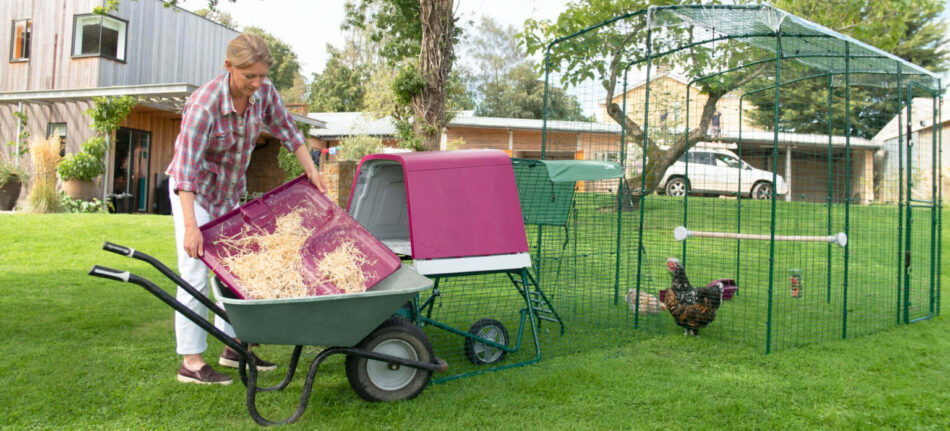
This entry was posted in Chickens
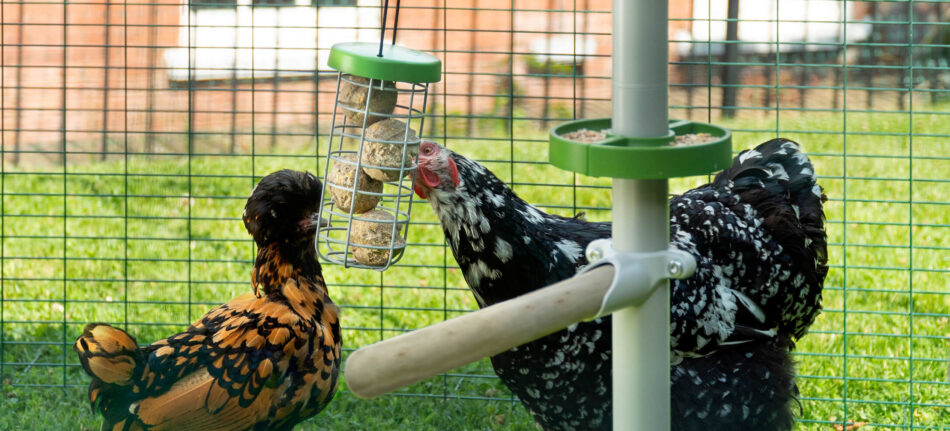
Bringing home new chickens is an exciting time! Whether you’ve just adopted full-grown hens, or selected chicks from a store or breeder, your new fluffy bundles will need a gentle hand. If it’s your first time owning chickens, or adding hens to your existing flock, a few preparations such as a solid chicken coop, run, and accessories will go a long way to ensure a warm homecoming for your new feathered friends.
Preparing for your new chickens
Getting your flock’s home ready for new arrivals is almost as much fun as watching them strut around in their space for the first time! But there are also things to consider when deciding how and when you will be bringing your new chickens home. And, if you have an existing flock, you’ll want to decide how to quarantine your new chickens and how to best introduce them when the time comes. Chicken coops, freestanding chicken perches, and a variety of chicken toys are all excellent tools to help you welcome your new chickens home. Other special considerations will need to be taken if you’re bringing home chicks, as they will need special accommodations until their adult feathers come in. No matter what type or how many chickens you’re adding to your flock, the following tips will make their transition as easy as possible!
Transporting your new chickens
You’ve selected your new feathery-family members, but have you given thought to how you’ll get them home? Some things to consider:
- The number of chickens you’re bringing home
- If you’re bringing home full-sized adult chickens or chicks
- The type of vehicle you’ll be driving
- Length of the journey home
If the journey home with your new chickens is under an hour, water will not be necessary. For moving long distance with your chickens, consider a scheduled stop to offer water. Don’t worry about offering food – your new chickens will likely be too nervous to eat, and adding food to their stressed bodies may cause digestive upset. They may even be too nervous to drink, and that’s fine! Offer water again once you’ve got them settled in their coop at home.
Travelling with full grown chickens
Adult chickens can be transported in wire dog crates safely, but should have towels or blankets placed in the bottom and part way up the sides to prevent toes from getting caught in the gaps. If you’re only bringing home a couple of hens, a plastic-sided dog or cat kennel can be used so long as they are not overcrowded. If your chickens will be riding home in an enclosed vehicle, you may also consider bringing them home in a cardboard box of adequate size. Boxes from small appliances or similar items are a great size for a few hens. Just be sure to poke some holes in the top and sides of the box for ventilation before placing the chickens in their cardboard shuttle!
Travelling with chicks
Chicks are easily transported in hard-sided dog or cat kennels, or smaller cardboard boxes with proper ventilation. Pine shavings, newspaper, or straw should be used for bedding for chick-transports as their smaller claws can become easily snagged in the fibres of fabrics. Most stores provide disposable transport kennels with the purchase of your chicks.
Bringing home new baby chicks
If you’re bringing home chicks, it’s important to know how old they are. Until they are 12 weeks old, chicks will require special housing with a heat source. Chick “brooder” pens can be purchased, or fashioned from a DIY project. Whichever method you choose, be sure the chicks have ample ventilation and space for several weeks. Once chicks begin growing adult feathers in place of their fluffy down, they’ll be able to flap and hop to impressive heights! Make sure the sides of the brooder pen are high enough to keep them contained.
A quick checklist of items needed for bringing chicks home will get both you and your fluffy bundles off to a great start:
- A brooder pen, rated for the number of chicks you plan to house
- Chick-starter crumbles
- Chick feeder
- Chick grit (chickens need grit to digest food properly)
- A heat lamp with a clamp or adjustable base (the height of the heat lamp will need to be adjusted as the chicks mature)
- Chick-specific gravity waterer
- Bedding such as pine shavings, shredded newspaper, or a shallow layer of straw
- Keep electrolytes and probiotics on hand to add to their water if any chicks appear ill
Your chicks will need to be checked daily. They are notorious for spilling their feed and dirtying their water during play! Chicks have a lot of energy, so be sure they have ample room in their chicken pen to play and stretch their legs and wings. If the sides of the brooder are high enough, try adding a commercially bought chick-perching station, or make one of your own design!
Getting your home ready for new chickens
If you’re bringing home adult chickens, they’re ready to go into their coop and run right away. The ideal chicken coop is easy-to-clean, with ample ventilation, and has features that will delight both you and your hens! And when it comes to chicken runs, bigger is always better. With plenty of room to sleep and play safely, your new chickens will adjust to their home quickly and easily.
The ultimate hen setup is an Eglu Cube with an attached walk-in chicken run. Your new chickens will feel safe and secure, and you’ll love the chicken-keeping features like a nesting box door, removable droppings tray, and a twist-to-close coop door to tuck hens in for the night. Plus, with the spacious walk-in run, you can spend time with your flock and customize their space with ease!
Chicken perches give hens an elevated view of their new surroundings, which will help them feel comfortable faster in a new environment. Or, for optimum perching space and aerial views, a PoleTree Chicken Perch can be added to your walk-in chicken run. Add in some chicken treat dispensers, and your new hens will feel right at home in no time!
Top weather protection tips for hens
Weather can also wreak havoc on your flock. The main dangers to chickens are extreme heat and extreme cold. Like most animals, chickens have a biological rhythm to help them prepare for the changing seasons, but will appreciate help from their humans!
For summer weather, these tips will help keep your chickens cool:
- Create shaded areas with chicken run covers
- Have plenty of fresh water available
- Offer frozen corn or other veggies as treats on hot days
- Add chicken-electrolytes to their water periodically
- Monitor for signs of heat stress
Heat takes a toll on chickens more so than cold, so stay vigilant during warmer months to ensure your flock stays as comfortable as possible.
Chickens moult in preparation for winter, and will grow dense, fluffy down feathers to help keep them warm. Things you can do to help your hens in the cold include:
Keeping your chickens healthy in the winter takes a little effort, but your hens will appreciate the gesture! When chickens are kept in prime condition during the cold months, they’ll be much more likely to continue laying, despite the cooler temperatures.
Year-round weather protection should include covering your chickens’ runs to keep precipitation out (muddy conditions create a breeding ground for parasites and bacteria) and provide wind breaks. You may also consider a chicken coops to move your hens around the yard and into shaded or covered areas when needed. Chicken tractors are a great option for flocks kept in areas where tornadoes or hurricanes are commonplace, as they can be moved quickly in preparation for wild weather.
Introducing new chickens to your flock
If you’re a seasoned chicken-keeper and are adding new chickens to your existing flock, you’ll need to quarantine your new chickens for about a month. This practice is two-fold: to monitor new hens for potential illness, and to slowly introduce new arrivals to their flock-mates.
The following steps should be taken when quarantining new chickens:
-
- Set up a quarantine coop and run for new chickens. This setup should be as similar as possible to your main coop and run to make transitioning as easy as possible. Make sure your quarantine coop is far away from your flock’s housing to prevent the spread of potential airborne illnesses. Having an additional setup is beneficial not only for new arrivals, but also for separating ill or injured chickens as needed.
- Monitor for illness during the first 2 weeks of quarantine. The majority of communicable chicken-diseases will present symptoms by this point. Contact your veterinarian if you notice any unusual behaviour from your chickens.
- Once the concern of potential illness has passed, slowly move your new chickens closer to your existing flock. Having a mobile chicken coop or wheels for your chicken coop will make introductions even easier! You can also set up a chicken fence around the perimeter of either coop and run to allow the chickens to get to know each other through the safety of the run wire.
- After your chickens have introduced themselves through fencing and become accustomed to each other’s company, move your now-not-as-new chickens to run with the rest of your flock!
Even though they’ve been introduced over time, chickens will still establish a pecking order once new hens are added to the flock. This is a normal process that all flocks work through, and while it may be alarming to witness your chickens sparring with each other, they should all settle down within a few minutes. Monitor for any injuries or excessive disagreements between your hens, but most flocks determine their hierarchies quickly!
Bringing home chickens to other pets
Chickens may not be the only animals that need introductions to new flock members. Especially if you’ve never had chickens before, your other household pets will need to meet their new feathered friends!
Dogs and cats often do well around chickens, but some breeds or individual pets can encounter obstacles when seeing birds. Why is this? Cats and dogs are predators by nature, and chickens are prey animals. The prey-drive may be triggered in your dog or cat at the sight of their flapping, clucking yard-mates. And in turn, your chickens may react as animals of prey do: frightened!
The best way to ensure safety and minimize stress for both your chickens and your other pets, make sure your chickens are safely secured in their run before introductions are made. Dogs should be kept on a leash during the first few introductions to avoid jumping on the run and upsetting your chickens. Be sure to reward your dog’s good behaviour with dog treats!
If you have a large area for your chickens, you may wonder if you can keep your chickens with other pets. If certain accommodations are made, yes! Other pets that house well with chickens are:
- Rabbits
- Goats
- Sheep
- Livestock guardian dogs (dogs accustomed to living with farm animals – particularly birds)
- Cats
- Horses or donkeys
- Other species of birds such as quail, pheasants, or female ducks (male ducks can be too aggressive with chickens)
Chickens are at the bottom of the animal hierarchy, and as such are usually submissive to other pets. Just be sure they aren’t bullied for their mild nature! Follow the same quarantine and introduction methods as you would with new flock members to allow ample time for your different species to get acquainted.
When will new hens start laying eggs?
You’ve made a valiant effort to make your new chickens comfortable in their new home, but it’s been weeks and they still aren’t laying eggs. Don’t get discouraged! Chickens are very sensitive animals, and their laying schedules are strongly affected by stress. And, if you adopted young hens, they may not be of laying age yet. You can expect hens to start laying eggs between 18-22 weeks of age.
There are also many ways to help your chickens lay more eggs, but as long as all of their needs are met, you can expect newly added hens to resume egg production once they’re settled into their new home. If your new hens aren’t moulting, are of laying age, and haven’t produced any eggs after a month or two in their new home, reach out to your veterinarian. And, if you haven’t already, read up on the breeds of chickens to get an idea of how many eggs and the laying frequency you can expect from them.
Getting into the routine
Thankfully, birds of a feather flock together, so your new chickens will take their routine cues from their flockmates! But if this is your first flock, you’ll need to show them the ropes. Setting a daily routine will help chickens thrive in their new environment.
First, you’ll need to decide what type of routine works best for you, the chicken-keeper. Do you want to feed daily, or leave feed out free-choice? Do you enjoy tucking your hens into their coop at night and letting them out every morning, or does the idea of an automatic chicken coop door appeal to you? Does your flock size require that you clean your chickens’ coop and run daily, or can you clean their space as needed?
Chickens love the predictability and stability of a routine, so whatever routine you decide on should be reinforced daily. It takes humans about 2 weeks to create a habit, and you should expect your chickens to catch onto their new routine in that amount of time or less! Once a routine has been established, chicken-keeping will be a breeze!
Chicken keeping with Omlet
Getting new chickens is a wonderful experience with the right tools and knowledge. Preparation is essential to success as a chicken-keeper, and getting off on the right foot will help your chickens adjust to their new environment quickly and safely. Our products are designed to help new chickens and new chicken-keepers start their journey together! We take the guesswork out of setting up ideal chicken housing and enrichment for both hens and humans. Large chicken coops for your growing flock, chicken toys, and Freestanding chicken perches are just some of the products that Omlet has created to deepen the bond between hens and their keepers. And, our dedicated team of experts are always ready to answer any questions you may have!
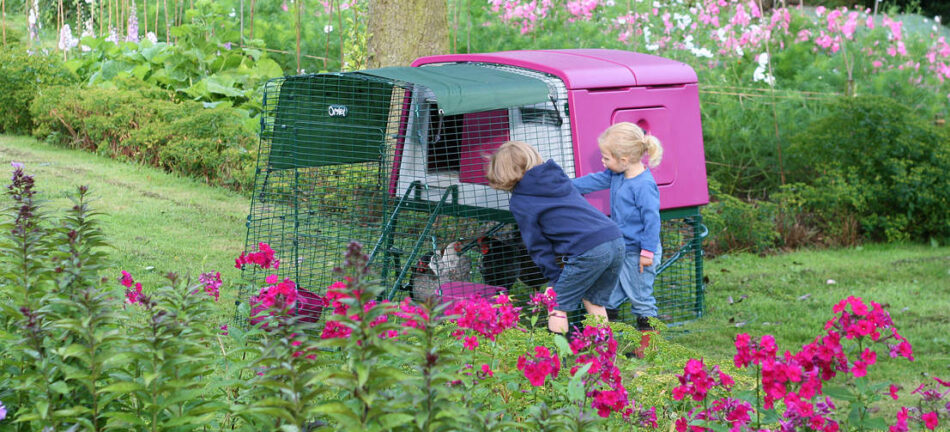
This entry was posted in Chickens
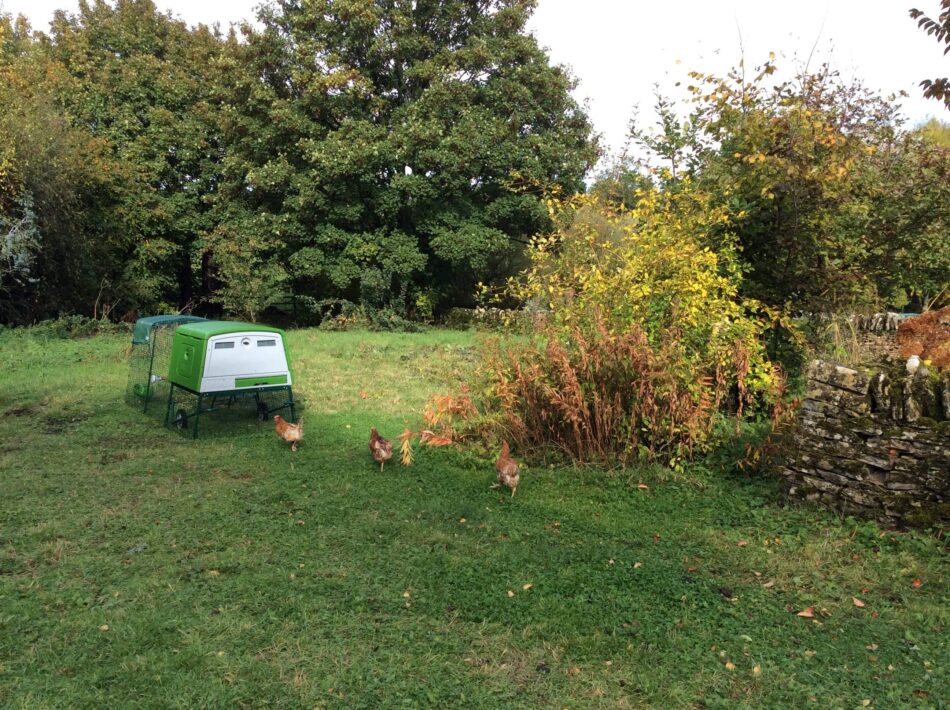
Why keep chickens in retirement?
Whilst retirement is undoubtedly a relaxing and well-deserved break, this stage of life can also bring on feelings of loneliness, which is why many, like Mary, take on a new hobby or get a pet. Chickens make for the ultimate retirement animals, being excellent companions, low maintenance, and come with the added bonus of providing a delicious breakfast every day! After all, no one ever said you had to be a spring chicken to keep them!
We recently spoke to Mary who has taken up chicken keeping during retirement, after deciding to adopt three ex-caged birds from one of her local BHWT rescue centres in September earlier this year. When asked if she would be happy to share her experience so far, she couldn’t wait to tell us all about her flock and the journey they’ve all been on.
What you’ll need to start keeping chickens in retirement
Getting started on your chicken keeping journey is easy with the right equipment. A low maintenance and easy to clean chicken coop, like the Eglu Cube, will give you more time to enjoy your new gardening companions. This raised chicken coop is also the perfect height for collecting eggs and pulling out the droppings tray to tip into your compost bin. The Eglu Cube house is big enough for 3 – 6 large hens, and if you choose a good laying breed or rescue ex-battery hens, that will get you 2- 4 fresh eggs a day! Extend the integral run at any time to give them more secure space, or attach to a larger Walk In Chicken Run so you can easily spend time with your feathered friends.
Add an Automatic Chicken Coop Door to the house to make chicken keeping even easier. The Autodoor will let your chickens out at sunrise, and shut them back in at sunset, so you don’t need to change your routine or worry about them when out and about.
What’s it like keeping chickens in retirement?
When we spoke to Mary, UK avian flu regulations had been enforced just a matter of days before. For a comprehensive guide on what the current guidelines are please refer to Everything You Need To Know About Avian Flu.
I’ve had them for about 8 weeks now. All of it’s quite new to me really! It’s the first time I’ve had chickens and I haven’t handled chickens before. I do think it was quite helpful having the What The Cluck book, which has been great and it’s been nice to refer back to. It’s been great fun and a learning curve.
When they first arrived, they all laid an egg the day after I had them but after that one of them wasn’t laying at all and she definitely looked rather sorry for herself compared to the others – she wasn’t eating and drinking as much either and she would just be standing there for a while. I did call the BHWT who were very helpful though and I took her to the vet. The avian specialist couldn’t find anything actually wrong but she was really moulting and just needed time and feeding up. Fortunately, she has since improved!
Since the avian flu restrictions, I shut them away, which is a shame because they were enjoying foraging! It does feel very sad really. There are leaves everywhere at the moment and they look so lovely amongst them!
How was setting up your Omlet chicken coop and run?
I rather left the task to my husband but the Omlet manuals are very comprehensive! I think the nesting box is excellent and it’s lovely to have the automatic door to let them out first thing in the morning and make sure they’re secure at night. It’s great being able to move [the coop] about too!
“Funnily enough, it’s quite the motivation to get up in the morning. They become a reason to get up early.”
Have you been doing a lot of cooking with the eggs?
Well, yes – a fair bit! I’ve really noticed over the two months I’ve had them the yolk has really yellowed/oranged up. It’s been very nice to be able to give family and friends eggs and everyone says how lovely they taste.
Has there been anything unexpected about chicken-keeping?
One thing I have been concerned about is that I have 2 cats – both of them are hunters. I was a bit concerned about how they would be but they’ve actually given them a very wide berth. They simply sort of look at them and go round the end of the garden!
So, do you think retirement is a good time to keep chickens?
Oh yes because you’re around a whole lot more! I love being outside and gardening anyway, and now it’s definitely an added incentive to be out there, wasting my time, watching them. They all sort of come and see what you’re doing and if you turn anything over, they’re in there looking for delicacies.
“They are fascinating and entertaining and terrible time wasters!”
For Mary, chickens have introduced new joy to her garden, even more reason to spend time outside and fresh eggs for her bakes. As she continues her journey, we’ll be catching up again in a few month’s time, so stayed tuned to read the next part of Mary’s retirement chicken keeping adventure!
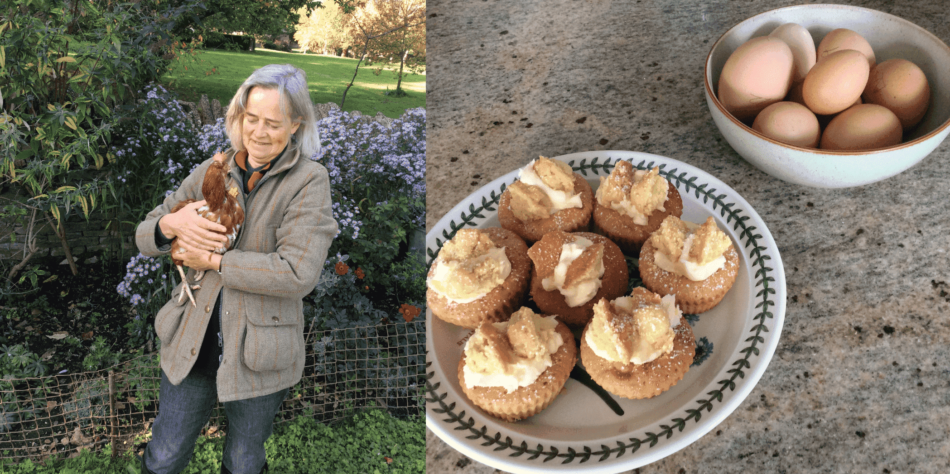
Mary’s Omlet setup was gifted by Omlet.
This entry was posted in Chickens
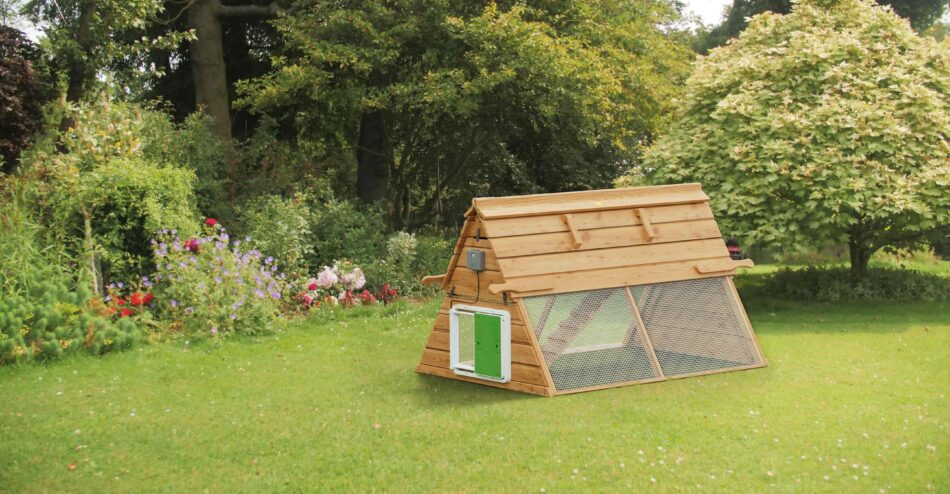
Do you have a wooden chicken coop in need of some home improvements? All wooden coops need routine maintenance and refurbishing – sometimes on a yearly basis. But how long should you expect a wooden chicken coop to last?
Chickens have been kept in various structures throughout history: barns, coops, even baskets! But over time coops have become the most popular hen-housing option, with wood being the most common material used for construction. Wood is easy to work with and relatively inexpensive, which makes it a favorite among DIY enthusiasts and coop supply companies alike. But the downside to wood is that it does not withstand the test of time and will inevitably require upkeep over the years.
When considering whether to make updates to a wooden chicken coop or to start fresh with a new design, several factors should be considered: Do you like the idea of a coop that can be easily moved? Easily cleaned? Resistant to mites, moisture buildup, and predators? If so, changing from a wooden coop to a plastic chicken coop will be a better option!
“If it ain’t broke, don’t fix it.”
This proverb holds true for many things, but wooden chicken coops are not among them! Even if your chickens’ wooden coop seems structurally sound, attention to detail is crucial to the health and wellbeing of your hens. If you notice the following issues with your wooden coop, it’s time to make repairs:
- Moisture buildup, or the presence of mold or mildew
- Sagging boards, gaps, or holes that cause drafts
- Rotting wood
It’s important to remove any affected boards and replace them with treated wood. If the siding or roof of the coop is involved, you’ll need to cut out the affected sections. Rotting wood is not only a hazard to your chickens, it’s also breeding grounds for parasites and bacteria or fungus. Remove any questionable sections of your chickens’ coop as soon as possible!
Small repairs may not be time consuming, but replacing larger sections of a wooden chicken coop requires both time and resources. You’ll also need to evaluate if the affected sections are going to compromise the structural integrity of the rest of the coop. If so, it may be time for a new chicken coop.
Enter: plastic chicken coops
The alternative to traditional wooden coops is the Eglu Cube Chicken Coop. Made from sturdy plastic, these chicken coops are easy to clean, move, are predator resistant, and require zero maintenance. The twin-wall insulation keeps cold and heat out during their respective seasons, while maintaining just the right amount of ventilation to create healthy air circulation. Additionally, these plastic coops can be pressure washed and thoroughly disinfected, creating a much healthier environment for your hens.
The Eglu Cube Chicken Coop never has to be painted, re-roofed, or weather treated like traditional wooden chicken coops – saving countless hours and dollars. It’s easy to assemble, and once erected, this heavy-duty plastic chicken coop is easy to move around the yard with the help of its integrated wheels and handles!
Are your hens happy in their wooden coop? If their coop is drafty, poorly insulated, or harboring mold or parasites, it’s definitely time to make a change!
Eglus for egg-layers
Aside from scoring bonus points for “being different,” Eglu chicken coops also earn high marks among chickens! Providing a cozy space, the Eglu’s insulating design utilizes your hens’ body heat to keep them warm even on the coldest nights. The Eglu Cube and Eglu Go Up Chicken Coops both offer the raised roosting space that chickens seek out at bedtime. Add in an automatic chicken coop door and you’ll be sure your hens are tucked in tight every night!
Plastic surfaces are inhospitable for parasites such as mites that so often plague chickens. And with the unique design of the Eglu, just the right amount of air circulation takes place without letting in drafts. No moisture buildup, mildew, or mold in a well ventilated coop makes for healthy and happy hens.
No more small roosting bars for your birds to balance on overnight – the Eglu Cube has an entire roosting rack complete with a droppings tray that can be easily removed and cleaned. Your hens will appreciate the break their toes receive when they’re able to get as comfy as they please at bedtime!
Eglus for egg-aficionados
Loved by chickens, but adored by their keepers – Eglu chicken coops are an all-in-one solution for flock-tending! Plastic coops don’t require any routine maintenance, and all of our Eglu chicken coops have removable parts for quick, but thorough cleanings. Spray them down with a hose or pressure washer, and finish with a quick spray of chicken-safe disinfectant for a fresh coop in minutes!
Not sure if you love where you decided to put your chickens’ coop? With integrated handles and wheels, the Eglu Cube can be moved with ease by one person! A chicken tractor that doesn’t require helping hands to move is always a win in the chicken-keepers book.
One and done – once an Eglu is assembled, that’s it! No maintenance, painting, removing rotten pieces, or making modifications. From the time the last piece goes into place, an Eglu is ready for hens for many years to come.
Eglus are built for winter
Not just a clever play on words, the Eglu’s unique design offers your hens optimal warmth throughout the cold months. Similar to double-paned windows, the twin-layer walls offer superior insulation by keeping your hens’ body heat in and the cold air out. A pocket of air surrounds the entire Eglu while still maintaining proper ventilation. The result? A toasty warm, well ventilated chicken coop!
In the debate of “Eglu Cube vs Wooden Chicken Coop – Which Will Stay Warmer?”, the Eglu Cube is the clear winner. Wood is too porous to truly insulate, and while spray or roll-insulation can be utilized in wooden coops, the process of layering such material between two sections of wood makes the coop much too heavy to move. Air as an insulator is much lighter and more effective for trapping heat.
No added insulation is needed with an Eglu chicken coop, unless your area has sustained, frigid temperatures. Optional extreme weather jackets can be added as a protective layer in climates that experience severe winter weather. All you need to do to ensure your hens stay warm in their Eglu during winter nights is close them in – the Eglu and your hens’ body heat will do the rest!
Wooden coop vs plastic coop care and upkeep
It’s important to remember that all wooden coops will require ongoing repairs and upkeep. Common wooden coop maintenance includes:
- Replacing weather-worn or rotten boards
- Hosing down or washing, allowing several hours for the wood to dry
- Reapplying paint or weather treatment (must be chicken-safe!)
- Replacing shingles on roofs
- Patching holes created by insects
- Applying diatomaceous earth or other chicken-safe pest control products to the interior and exterior perimeter
In contrast, plastic chicken coops such as the Eglu Cube don’t require any maintenance over the years. Once assembled, they’re ready to keep chickens safe and healthy for years to come! Pressure washing or hosing down the removable interior pieces and changing the bedding in the nesting area and in the droppings tray is the extent of maintenance for plastic chicken coops.
Complete the setup
We have an entire line of chicken products dedicated to keeping your chickens healthy and happy, while ensuring that caring for your flock is easy and enjoyable. Some of the companion products that integrate seamlessly with an Eglu chicken coop include:
Not only will you have peace of mind knowing that these products will not require routine maintenance, but also in the confidence that your hens are housed in meticulously designed coops and runs that will keep them safe and feeling their best!
Chicken chores? We don’t think so!
At Omlet, we invent products that turn chores into enjoyable activities for you and your entire family. Our chicken products make caring for flocks easier than ever – and less time maintaining or cleaning your chickens’ area means more time to enjoy their company! Designed with new and seasoned chicken keepers in mind, our Eglu chicken coops check the list for all backyard flocks.
Ready to make the switch from a wooden chicken coop to a zero-maintenance plastic coop? Let us know, and our team of experts will help you pick out the perfect setup for your flock!
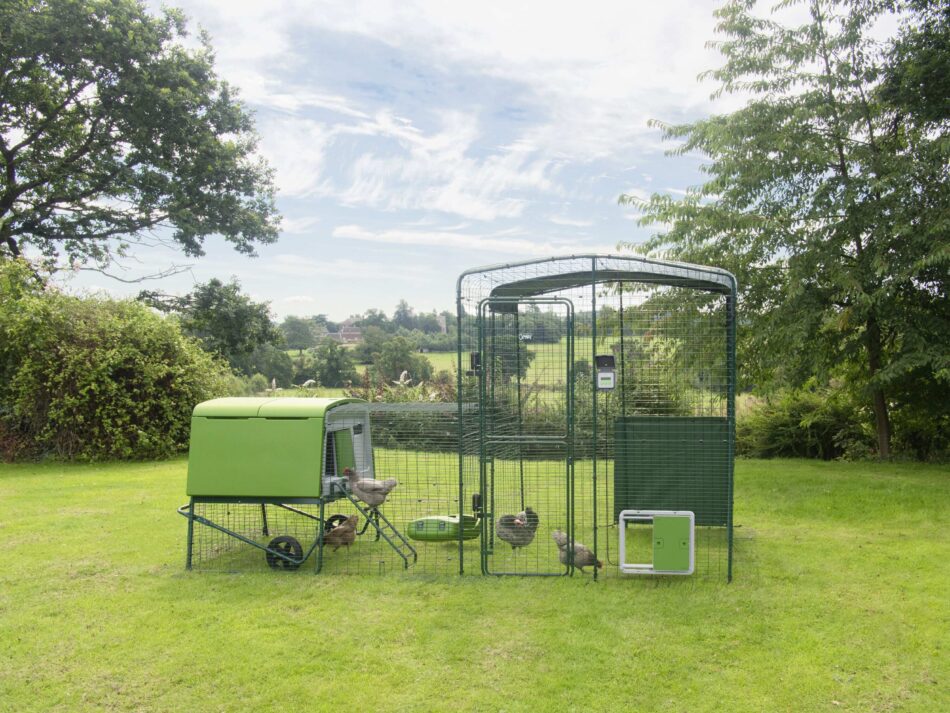
This entry was posted in Chickens
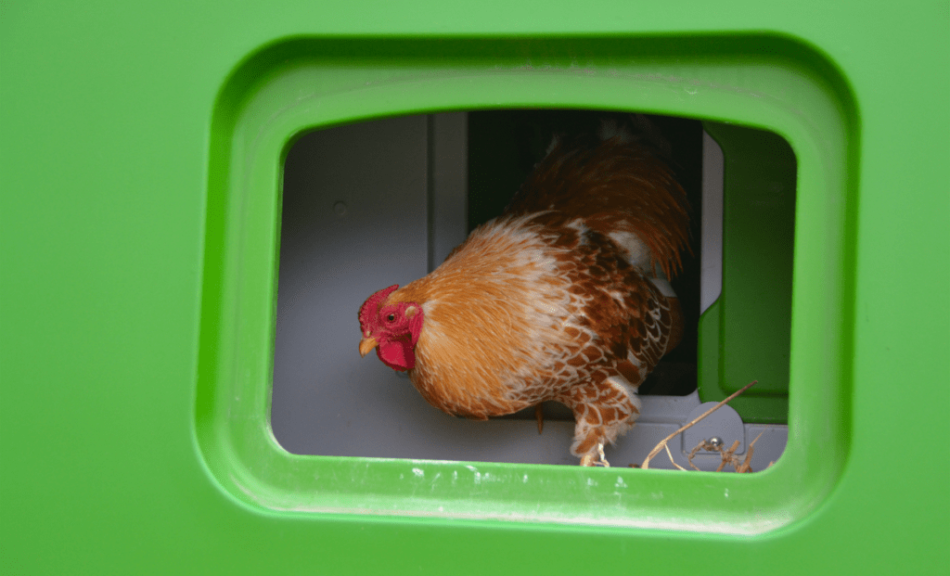
You’ve seen to your hens’ every need for months. Their coop is clean, they’re well fed (treats included!), entertained, and have finally shed their adolescent feathers and donned laying-age hen skirts. At last, your efforts are finally rewarded in a clutch of farm fresh eggs.
Your hands, basket, or apron (if you’re feeling fancy) are now full of those smooth cackleberries, and ready to go…where? You could keep them in store-bought containers, custom ordered cartons, or displayed on a countertop egg skelter. But where is the best place to keep them after that? Should you wash them? Leave them be?
From backyard flocks to large commercial operations, all chicken-keepers need to research the best methods for keeping fresh eggs, well, fresh!
Methods and misconceptions
Here are some of the most common methods of keeping freshly-laid eggs:
- Unwashed, on the countertop
- Washed, then refrigerated
- Sealed for long-term storage in an air-tight container at room temperature
There are some common misconceptions regarding these methods and the freshness they are able to sustain. You might be thinking:
Who wouldn’t wash their eggs?! I love my chickens, but I don’t love their mess!
When I buy eggs at the store, they’re refrigerated – surely that’s the best method?
I don’t want to find a partially-formed chick when I crack a room-temperature egg!
Fortunately, there are easy (and even scientific!) answers that can put your mind at ease and help you decide where to keep those nutrient-packed eggs!
Eggs on display
Let’s start with the most common method for small-batch chicken egg gatherers:
Fresh, unwashed eggs kept on the countertop at room temperature.
It’s a common fear that keeping eggs at room temperature will allow a fertilized egg to continue developing into a chick. However, fertilized chicken eggs need to be kept around 100.5 degrees Fahrenheit, maintain a humidity level of 65-70%, and be turned several times a day for 21 days in order to develop! Unless your countertop meets these requirements (and therefore be the largest incubator in your state!), fertilized eggs will not develop unless they remain under a broody hen, or placed promptly in an egg incubator.
The importance of unwashed eggs being kept at room temperature however, cannot be understated. Why is this so important? When eggs are laid by a hen, they are bathed in a protective barrier of the hen’s natural flora, called the “bloom.” This good-bacteria keeps the embryo safe from external bad-bacteria while it develops. Eggs also have semipermeable shells, which allows nutrients in and out of the membrane to nourish a growing chick. If the bloom is removed by washing, good and bad bacteria are able to move freely into the egg.
So what does this mean for egg-keepers? Simply put: if you wash the eggs you gather, you remove the natural, hen-given barrier that not only keeps the egg fresh longer, but may even push harmful bacteria into the egg.
This doesn’t mean that eggs stored on the countertop need to be filthy! You may want to keep a designated (emphasis on designated!) toothbrush or rag to remove large debris from the egg. There are also DIY or store-bought varieties of egg wipes that will loosen caked on messes without compromising the integrity of the bloom. Just remember- if an egg comes in contact with water, the bloom is compromised!
An added bonus of keeping eggs on the countertop is the visual appeal. Egg skelters are one of the many ways to artfully display the fruits of your girls’ labor!
Refrigerated eggs
If you’re a casual egg-consumer, or saving up for some holiday baking, refrigerating your chicken’s eggs may be your best option. Eggs can go straight into the fridge from the nesting box, or they can be washed first.
Fresh eggs can be washed in store-bought or homemade solutions, or under warm, running water. The water needs to be warmer than the egg you’re washing, and needs to remain in motion so that eggs aren’t soaking in a dirty rinse- both of these factors reduce the chance of bacteria being pushed into the egg. Once washed, eggs can be patted dry and placed in the fridge. All washed eggs need to be stored in the refrigerator or eaten promptly!
Refrigerated eggs (washed or unwashed) will remain fresh longer than their room temperature counterparts – several weeks longer, in fact. But it’s important to note that once eggs are refrigerated, they need to stay that way! Just as store bought eggs need to be kept chilled, fresh eggs (especially washed eggs) will spoil much faster going from fridge to countertop.
Long-term preservation
The last storage method is for long-term storage. Really long term!
You can “water glass” your eggs.
Water glassing is the method in which our ancestors used long before refrigeration or other preservation techniques were used. This method is simple and effective, and can be beneficial when needing to store eggs over the “fussy” season when hens aren’t feeling particularly productive!
To water glass eggs, you’ll need:
- Unwashed, freshly gathered eggs
- An airtight storage container
- Pickling lime
- Distilled or natural spring water
Once sealed, “glassed” eggs will remain fresh for up to 18 months!
If this method seems intriguing, be sure to do some research on the ratios needed for each ingredient, depending on how many eggs you plan to store.
Quality control: egg-checks
No matter which method you employ in storing your farm-fresh eggs, it’s always a good idea to do freshness-checks on any eggs you’re about to consume. One of the easiest methods is to place an egg in a glass of water. If the egg sinks, it’s fresh. If it turns on end (standing up), it might not be the freshest, but should still be safe to eat. If it floats – toss it!
Eggs become filled with gasses as a by-product of aging. Egg whites lose their viscosity and become watery. These lighter, air-filled eggs will float when placed in water!
If you don’t want to float your eggs, you can easily check their freshness by cracking them into separate containers before adding them to your skillet or mixing bowl. This method is particularly helpful when children are the primary gatherers and may be bringing in older eggs, or after going on vacation. You’ll know a rotten egg when you crack one!
In summary
- Fresh eggs can be stored a variety of ways, depending on quantity and duration needed.
- Eggs kept in the fridge need to remain in the fridge.
- Do not wash room temperature eggs.
- Once rinsed or cleaned with a solution, eggs must be refrigerated or used promptly.
- Check the freshness of your eggs by floating them in water just before using them, or by cracking individual eggs into a bowl before adding to dishes.
There you have it! Three simple and effective ways of storing your hens’ edible artwork.
Drop a line or a picture below to show how you store your farm eggs!
Please note: if you are offering your farm fresh eggs for sale, be sure to check your state’s guidelines for selling eggs. Some states require that farm eggs be sold unwashed, while others require washing and refrigeration. Additionally, some states may require eggs be given a “grade” before being sold to notate freshness.
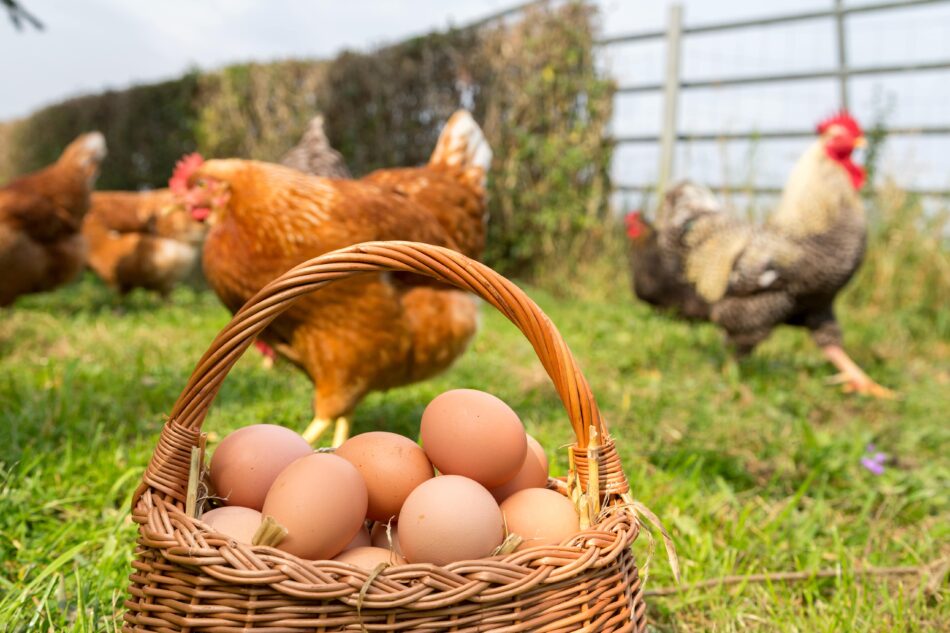
This entry was posted in Chickens
Chickens are a pet that give a return on your investment. Not just through a rewarding emotional bond that is experienced between pet and owner (though certainly that too), but through tangible goods: delicious, nutritious, and gorgeous eggs. The nutritional makeup of an egg alone is amazing, but you can also analyse your chickens’ eggs to get a glimpse into their overall health. What do your hens’ eggs say about their health? From laying frequency, egg size, shape, colour, and texture — here’s what your daily gathering can tell you about your flock.
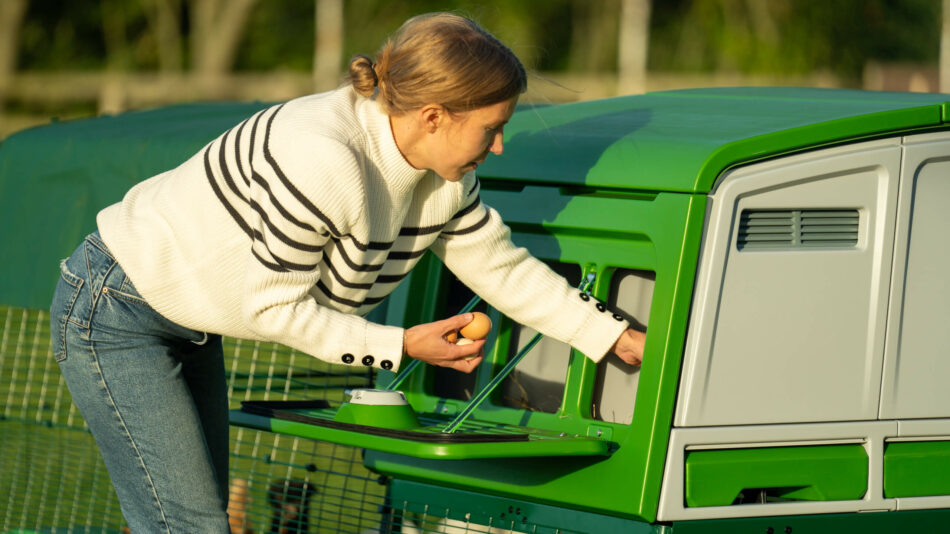
Nutritional value of eggs
Healthy hens lay healthy eggs, and it’s hard to beat their nutritional value. On average, one chicken egg contains just 75 calories, but 5 grams of protein. Along with milk, eggs hold the “gold standard” for biological protein value. Eggs also contain vitamins and minerals essential to human health. And they’re versatile too — there are so many different ways to enjoy eggs, either on their own or as part of a recipe. When your hens are laying healthy looking eggs on the regular, it means they’re receiving proper nutrition and feel safe in the nesting area of their chicken coop.
When you aren’t collecting these nutritional offerings as often as usual, or if your hens’ eggs begin to look or feel unusual, there may be underlying issues at play. From illness to stress, here are some ways your flock’s eggs can hint at a health concern.
Change in egg laying frequency
How often do hens lay eggs? The answer is a bit more complex than the common notion of “an egg a day,” and many factors are taken into account when determining what is normal egg production for a hen. Breed, age, health, and time of year all affect how many eggs chickens lay.
Among the many different chicken breeds that are considered good layers (those that can lay upwards of 300 eggs per year), some well known egg producers include:
Ornamental and smaller chicken breeds lay less frequently, with some only laying a few eggs each month.
Hens that are not feeling well, or are malnourished will lay less frequently. Flock discord, inadequate nutrition, and overcrowding are a handful of stressors that can take a toll on egg production. Make sure your hens have access to clean water and quality layer pellets at all times to ensure they’re getting the calories and nourishment they need. Adding scratch grains, chicken treats, and healthy kitchen scraps or safe foods from the garden to their diet will also give hens a nutritional boost.
Hens will inevitably lay less, or stop laying eggs altogether in the winter. A hen’s ovulation cycle is based on daylight hours, so once the days shorten, you can expect egg production to slow down. This is a hen’s natural reaction to the changing seasons as they prepare to reallocate energy to keep warm instead of laying eggs. Your hens will resume a normal laying schedule closer to spring, as days grow longer.
Molting season
Another annual reason for a decrease in egg production is a process called “moulting.” Moulting is the process of shedding old feathers and regrowing new ones to replace them. This process also occurs in preparation for winter – so as the days grow shorter, your hens will begin to lose their dingy feathers in favour of new, more dense feathers to keep them warm. The result is a beautiful, vibrant new outfit of feathers for your hens – but less eggs for you to gather. Moulting takes a lot of energy, so expect your chickens to be on “lay-cation” for 8-16 weeks. Helping your hens through their moult will better prepare your flock for their annual feather-renewal.
Eggs of a different colour
Did you know that chickens lay eggs in several different colours? You’ve probably seen white and brown eggs, but some chickens can lay eggs in shades of green, blue, and even pink. So, what causes such a variety of colours?
Genetics determine what colour eggs a hen will lay. Some breeds of chickens have a standard colour you can expect from them. For example, you can count on Leghorns to lay white eggs, Orpingtons lay brown eggs, and Ameraucanas lay blue eggs. But different shades such as olive are the result of a hybrid hen – a hen bred from a combination of blue and brown egg genes. For example, if you bred an Orpington (brown egg genetics) rooster with an Ameraucana (blue egg genetics) hen, the result would be an “olive egger” hen that would lay green eggs. Egg colour should be consistent with the hen laying them, and different coloured eggs are not a cause for concern unless a hen suddenly starts laying a different shade from what is normal for them.
All eggs begin with a white shell, but the hen laying the egg adds a pigment to them as they make their way to be laid. This pigment only colours the shell, and does not penetrate the membrane.
Pro tip: you can get an idea of the colour eggs a hen lays by looking at their earlobes. Hens with white earlobes will lay white eggs, and hens with red earlobes will lay brown eggs. This technique is not as accurate for pigmented eggs (blue, green or pink), as hybrid-chickens will have a variety of colours to their earlobes. Still, it’s fun to try this prediction-test with your flock.
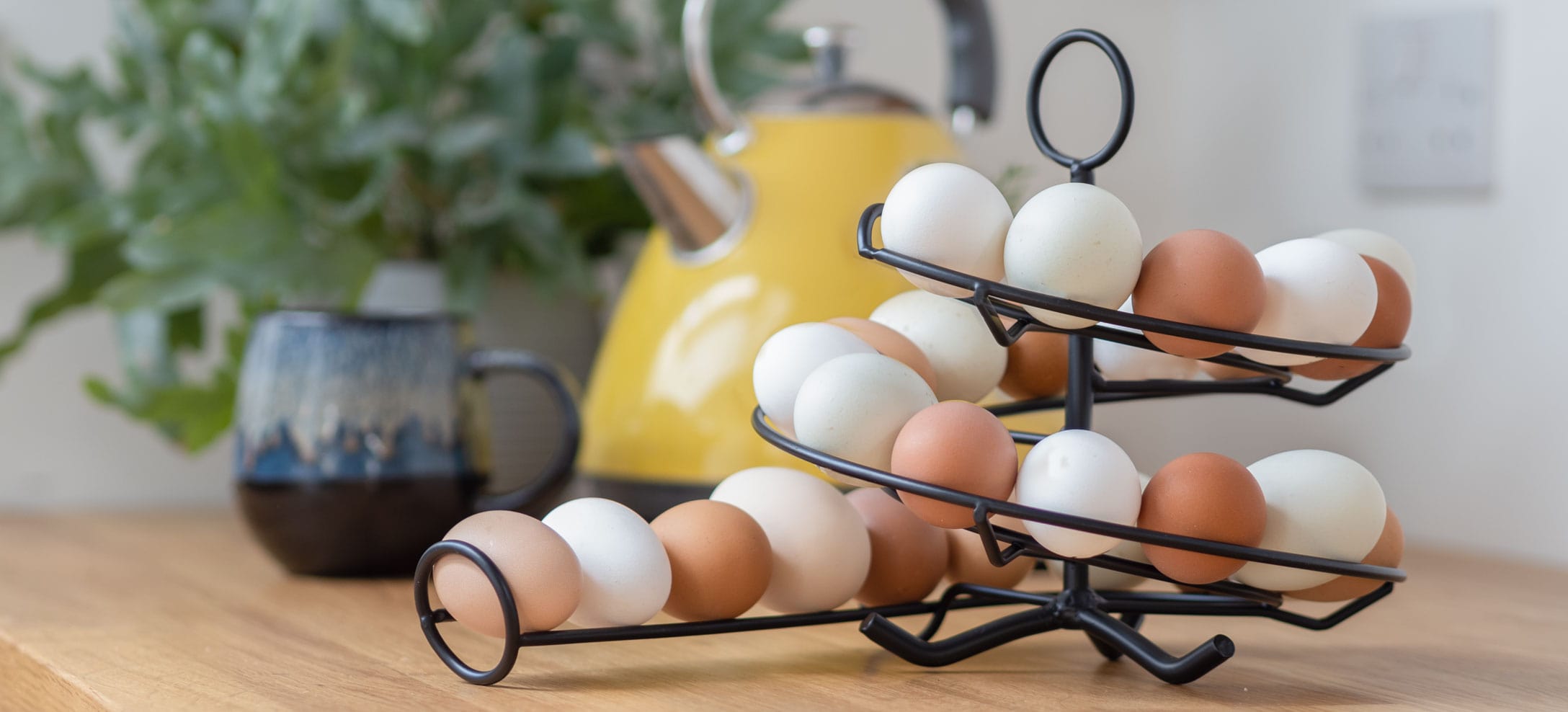
Double yolks
In a rare, but completely normal phenomenon, chickens can lay eggs with two yolks inside. If fertilized and incubated or kept under a broody hen, double-yolked eggs can hatch twin chicks – but it’s more common for only one embryo to fully develop.
If you crack one of your chickens’ eggs and start seeing double, it’s the result of the hen releasing two yolks at the same time during ovulation — which then become encapsulated within one shell. It’s more common for newly-matured hens to lay double-yolked eggs, as their bodies are adjusting to ovulation. Laying eggs with two yolks can also be genetic, and hens may continue to do so for the duration of their egg-laying career.
Thin shell, or no shell at all
Have you ever collected eggs, only to find yourself flabbergasted by a squishy egg? Soft-shelled eggs feel like partially filled water balloons and can be very disconcerting to find in the nesting box. These strange, spongy eggs are actually laid without the presence of the shell; only the membrane. This most often occurs with high-producing hens, when their bodies simply cannot keep up with yolk production. Oftentimes they will lay a fully-formed egg, then lay a shell-less egg a few hours later.
The other most common reason for eggs having thin or missing shells is inadequate calcium in their diet. Warning signs leading up to shell-less eggs can be thinner shells, so take note if your hens’ eggs are suddenly much easier to crack, or if you find broken eggs in the nesting box. A lot of calcium is required to “fully clothe” a yolk, so be sure to feed quality layer pellets that contain added calcium. If you notice thinner shells or “naked” eggs, supplement your hens’ feed with crushed oyster shells or other chicken calcium supplements. You can also save egg shells after cracking them to crush or grind up and sprinkle on top of your hens’ feed. Be sure not to offer shells that have not been broken down into smaller pieces, as chickens can acquire a taste for eggs and will actually eat them straight out of the nesting box.
Boost your hens’ shell-producing ability with chicken supplements to ensure they have all of the vitamins and minerals they need. As an added bonus, supplements such as omega-3 fed to your chickens pass through to their eggs– and then to you when you eat them.
Looks can be deceiving
Sometimes an egg might look a little off, but it may be hard to place why. These common sights are usually no cause for concern unless they become the new normal.
Why is there blood on my chicken’s egg?
While it may look concerning, blood smears on an eggshell usually indicate that it came from a new layer (pullet). This issue should resolve on its own after the first few weeks of laying.
Why are my hen’s eggs long and skinny?
Also more common in pullets just starting to lay, eggs can sometimes take on an awkward shape or appearance. Young hens will often start laying smaller, elongated eggs that look almost pointed. If elongated eggs appear suddenly and regularly in mature hens, notify your veterinarian, as this could indicate illness.
Why do my chickens’ eggs have bumps, divots or ridges?
The texture of eggs is an excellent sign of potential nutritional deficiencies or stress in your flock. Any hens’ consistently laying eggs that do not have a round, smooth shell, are experiencing either stress or malnutrition. Make sure your chickens’ feed has adequate levels of protein, calcium, and vitamins and minerals. Overcrowding is often a source of stress for chickens, so give them plenty of room in a walk in chicken run or an area of chicken fencing during the day, and adequate space in their chicken coop at night.
Why is there a chalky film on my hens’ eggs?
An abundance of calcium in a flock’s diet can cause eggs to be laid with a chalky or waxy appearance. Brown eggs may take on a pink hue from this excess calcium, or you may see flecks of white on darker coloured eggs. To correct this, scale back on calcium supplements until the eggs take on a normal appearance once again. If the film persists but only with one or two hens, it’s more likely that you have a couple of hens that produce a thicker bloom (cuticle) layer than others. In this case, the waxy film is perfectly normal, and even beneficial.
Even though they may not look as appealing as “normal” eggs, most unusual looking eggs are safe to eat. Most of the time deformities lie within the shell only, with the inside of the egg remaining unaffected. Any eggs that have sustained damage to their shell should be discarded, as bacteria will have had the chance to enter through the compromised shell.
Chicken checks
Check in with your hens by doing regular chicken health checks to make sure everyone is in tip-top shape. Look for any new or unusual signs or symptoms in your chickens during this health check. It’s also a good idea to have an extra Eglu Go Chicken Coop setup for quarantining sick or new flock members.
Unusual eggs can sometimes point to illness. If you notice your chickens having symptoms accompanying irregular egg laying, or the prolonged presence of abnormal-looking eggs, it’s time to contact your veterinarian.
Omlet and your hens’ health
Eggs can tell you a lot about your hens’ health — but so can their appearance and activity level. That’s why we’ve made it easier and more enjoyable than ever to keep your flock fit and healthy. Our extra large chicken coops give everyone in your flock plenty of space to lay and roost, and our walk in chicken runs can be expanded to any dimension of your choosing — giving you plenty of space to spend time with them. Round out your setup with a customizable PoleTree Chicken Perch, and your hens will have the ideal space to keep them healthy and happy for years to come. With our ingeniously designed products, you’ll always know what your flock is up to, and that every part of their home has been carefully crafted for their health and happiness.
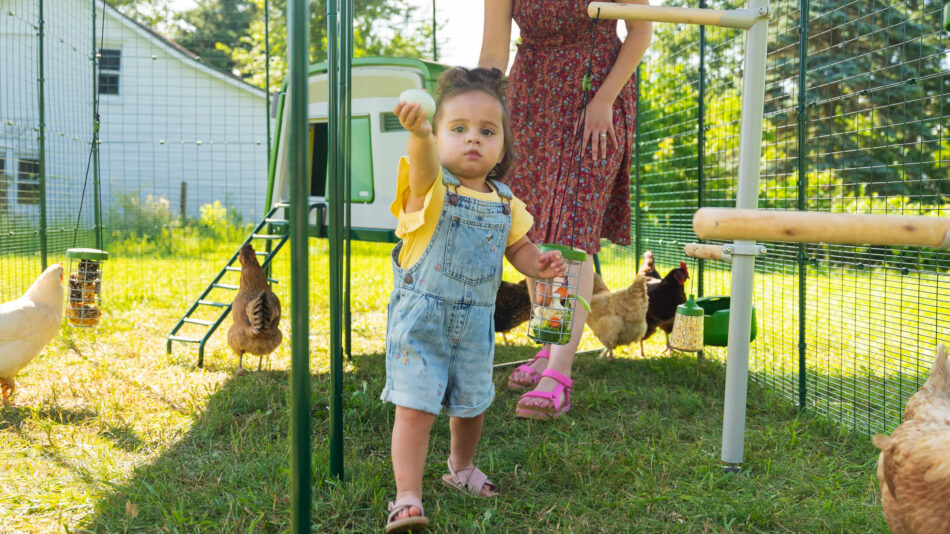

This entry was posted in Chickens
Did you know that chickens were domesticated thousands of years ago? Our favourite egg-laying friends have been part of farming practices since 2000-1500 BC! Long praised for their plumage, egg laying efficiency and ease of care, chickens are kept all over the world in backyards and barnyards alike.
But what else do chickens have to offer? What are the benefits of owning chickens?
Fresh eggs
It’s true that most people acquire chickens to have fresh eggs on a regular basis. Chickens have provided humans with delicious protein-packed cackleberries for centuries. In fact, different breeds of chickens have emerged over the years to enhance both egg production and egg composition. Through selective breeding, hens are capable of laying not only white eggs, but brown, blue, green, and even pink eggs!
Good laying hens can produce 5-6 eggs per week. They start laying when they are about 18 weeks old (although this can vary between breeds, with some breeds not reaching laying-age until 6 months), and will continue to lay eggs until they are 5 or 6 years old. A well-kept and fed backyard hen can lay up to 250 in the first year! Eggs start off small and elongated, but once a hen has some successful egg-laying-sessions under her belt, the eggs will be larger and more shapely. You can’t expect her to keep going at this rate though! Your hen will slowly taper off her egg production to about 80% in her second year, with a decrease of around 10% thereafter. That means if she laid 250 eggs her first year, the second year would yield around 200 eggs. Year three would yield around 175, and so forth.
Some of the best egg-producing breeds include: Rhode Island Reds, Plymouth Barred Rocks and Buff Orpingtons. If colourful eggs are what you seek, breeds such as Ameraucana Marans, Barred Rocks, and Welsummers. Some popular cross-breeds have been developed for egg colouration, and go by the common names of “Easter Eggers” or “Olive Eggers.”
Even chickens that are considered low-egg producers can still lay 2-4 eggs per week. As long as hens are happy and healthy, you’ll be provided with a steady stream of fresh eggs to enjoy!
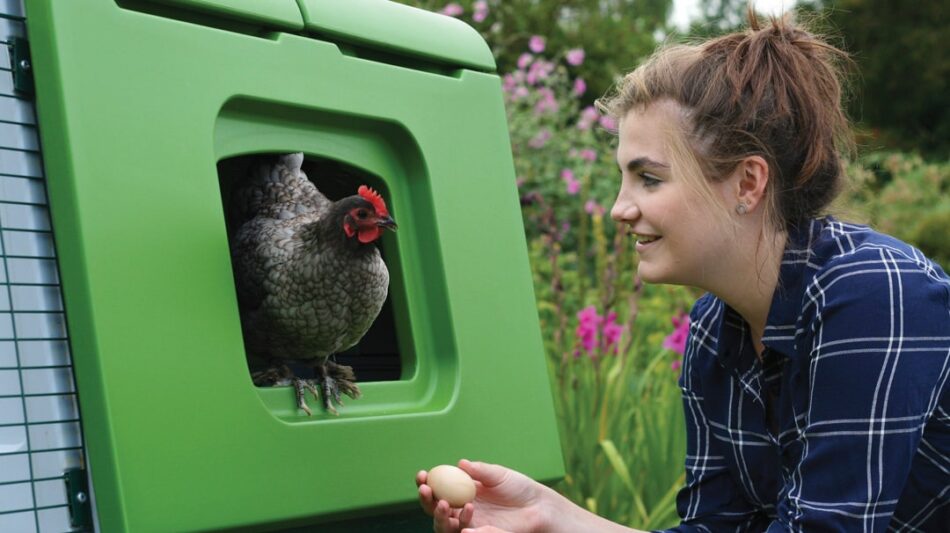
Pest control
Say goodbye to pests without calling the exterminator – just let your chickens take care of the creepy crawlies! Your flock will feast on just about every bug that plagues your yard. Ants, hookworms, moths, grasshoppers, ticks, centipedes, termites, spiders, and even scorpions are on the menu for chickens.
Insects are an excellent source of protein for your hens, and chasing bugs is enriching for them and entertaining for you! You’ll notice your chickens’ inner dinosaur (they are related, after all!) on display as they zoom around the yard after a wayward grasshopper or moth.
Feathers
Yes, we said feathers! Eggs get the most attention, and while they are definitely fun to look at, chickens have other visually appealing products of their nature.
Chicken plumage comes in a wide array of beautiful colours and patterns. Along with regular feather-loss, chickens moult once a year, which means they shed the majority of their feathers. The result is a DIY dream come true! Hop onto Pinterest for some amazing feather craft ideas, or design your own stunning arrangements. The best part? You don’t have to worry about them spoiling!
City chickens or country chickens
Did you know that many cities allow chickens in backyards? That means you can likely have a small flock of chickens and experience a small portion of farm life – right in your own neighbourhood!
Coops that will fit most backyard spaces include: the Eglu Go Up Chicken Coop or Eglu Go Chicken Coop. For larger spaces or flocks, the Eglu Cube Chicken Coop is the best choice. We’ve designed our entire line of Eglu Coops to be the whole package: a complete setup to fit into any space, large or small. Just imagine: what if you could enjoy life on a farm, right in the centre of town?
Be sure to check with your local ordinances, as most cities prohibit roosters, and have space requirements between coops and other homes.
Learning opportunities
Chickens are fascinating animals. They have social hierarchy within a flock, natural instincts to be observed, and provide eggs that can be utilized in multiple ways.
You’ll often see a “leading lady” among your flock that seems to call the shots! Other hens will move in submission to a dominant hen. If you have a rooster, he may act like a big deal, but there’s usually a hen behind him keeping him in line! Most animals that live in flocks, packs or herds have a social hierarchy, but observing your backyard flock is one of the best ways to understand the social network of creatures that live in groups.
The natural instincts of chickens are similar to their wild-counterparts. The closest-related wild animal to chickens are “junglefowl”, which can be found in the jungles of Southeast Asia. And going farther back, chickens have recently been linked to a famous ancestor: the T-Rex! So by watching your chickens scratch and peck the ground, chase insects, spar with each other, and lay eggs on a schedule, you’re actually witnessing instinctual behaviours shared with wild animals and long-extinct dinosaurs!
Eggs aren’t just for eating. Have you ever thought about incubating eggs? Small incubators can be purchased for home-hatching. Chicks hatch after just 21 days in an incubator, which makes incubating eggs an excellent home biology lesson. And by purchasing an egg candler, you can mark the progress of the chicks inside the egg. Children and adults alike will be mesmerized by this process! Eggs can also be displayed on your countertop for several weeks (if they are unwashed), or can be preserved by “glassing” in an air-tight container for display and future use.
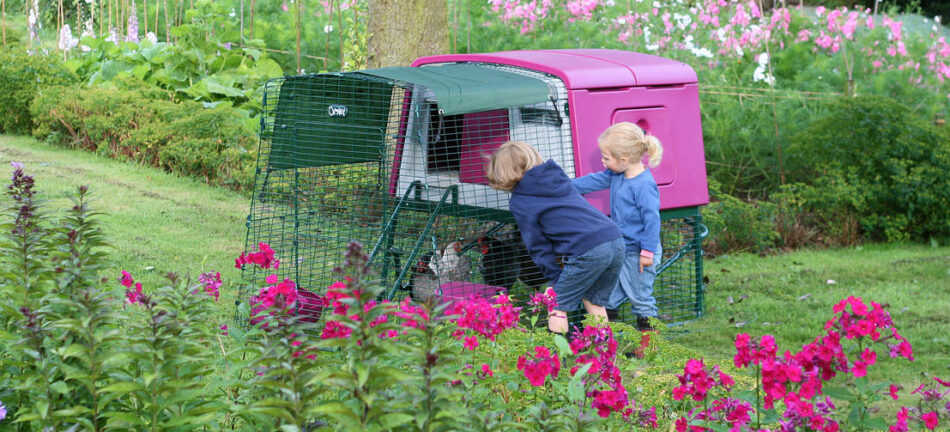
Composting companions
Are you tired of turning your compost pile? Let your chickens help! By giving your birds access to your compost piles, they’ll help the process along by keeping it bug-free and routinely turned. And while chicken poop might not be the most appealing part of having a flock, it’s actually great fertilizer! While your chickens scratch around in your compost, they’ll leave their own contribution!
Be sure to not let chickens have access to the compost until food scraps, coffee grounds, or other additives are decomposed to ensure they don’t ingest something harmful.
Lawn ornaments
People have long decorated their lawns with various sculptures, statues, and other decor. Why not add living art to your decorating scheme?
Chickens come in a wide array of colours and sizes, and even have different textured feathers! Choose Silkies, Frizzles, or Polish to add some fun texture to your flock. Breeds such as Barred Rocks, Laced Wyandottes, or Mille Fleurs will add a pop of colour to your yard that will rival any artificial accessory!
Much like keeping an aquarium, chickens add a beautiful and natural focal point to your home. And unlike fish, most chicken breeds get along with others, so mix and match to your heart’s content!
A backyard play-space
Chickens are naturally inquisitive and active! Create a backyard play space for them to foster their natural curiosity. Some fun and entertaining options include: the Chicken Swing, Freestanding Chicken Perch, PoleTree, or chicken toys.
Like kids at a park, your chickens will get a thrill out of swinging, perching, pecking, and hopping around their own playground. Add some chicken-safe potted herbs or other plants for even more stimulating play!
Affordable
Chickens are one of the most cost-effective pets to own. They are inexpensive to obtain, and if free-ranging is an option, feed costs are kept to a minimum. If a flock is contained to a coop and run, a combination of quality pellets and scratch will keep them well fed and happy. Chicken treats are a great way to incorporate some free-range finds into a cooped-up flock. Additional inexpensive diet add-ins include lettuce, fruits and vegetables.
When you consider all of the benefits chicken-ownership has to offer, the return on investment is high! Fresh eggs, lawn care, pest control, entertainment, education, and companionship are just a few of the joys that come with caring for a flock of chickens.
What are some of the benefits of owning chickens that you have experienced? We’d love to hear from you!
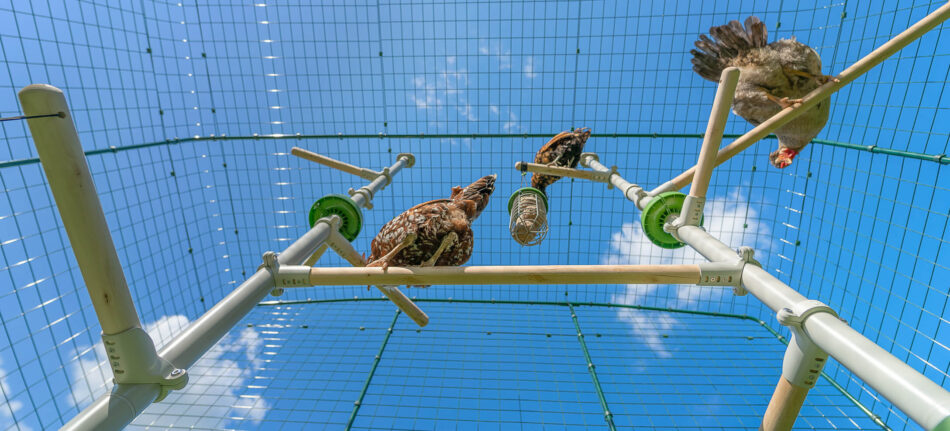
This entry was posted in Chickens
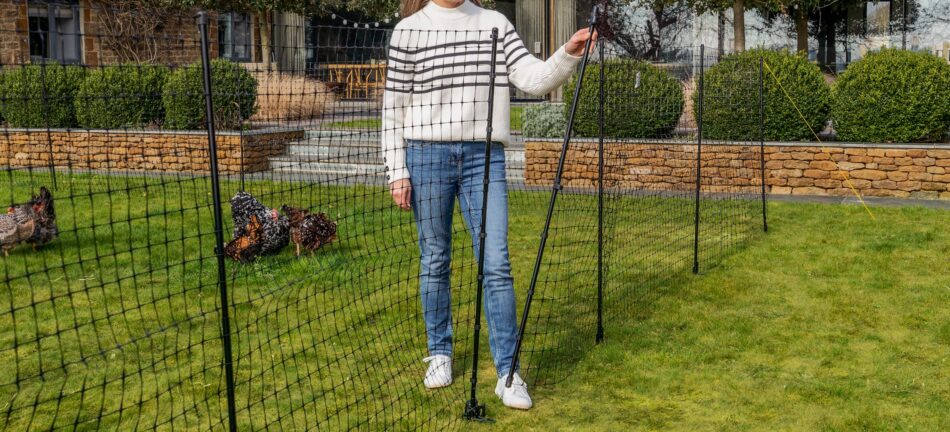
Choosing between chicken wire and chicken fencing is one of the first steps in getting your new hens set up in their new home. Both products focus on keeping your chickens safe within their new home. Our guide explores the key features of chicken wire vs chicken fencing, to help you decide which is right for you and your flock.
What is chicken wire?
Chicken wire is a type of wire mesh, most typically made from steel that is used to pen in chickens. The wire is thin and flexible, with the steel formed into hexagonal gaps that can vary in size. As well as using chicken wire for your flock, many people put it to other uses in their backyard. From creating pens for small animals, to protecting your plants, it can be used for a variety of tasks in the garden.
What is chicken fencing?
Chicken fencing does the same job as chicken wire, however it is more durable, and far easier to install. The fencing allows you to chicken-proof your garden, whilst easily giving your hens space to roam. Made from stronger materials, such as aluminium and polypropylene. You’ll also find chicken fencing tends to be higher than traditional wire solutions.
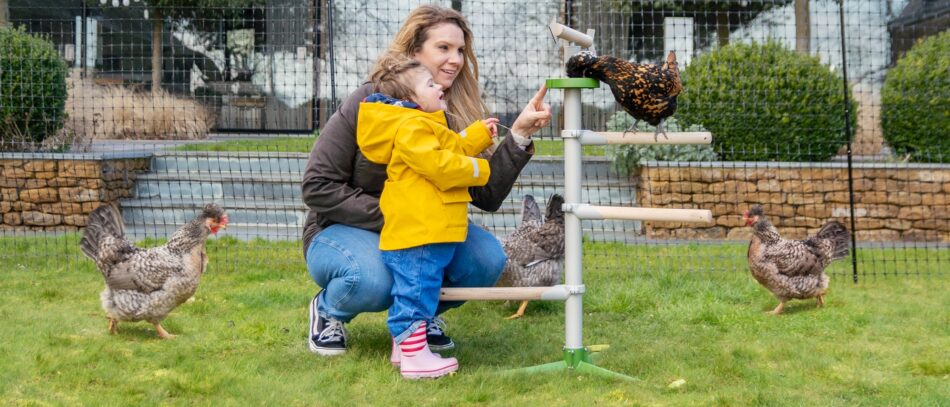
Chicken wire vs chicken fencing: 3 key differences
Designed to perform the same job in slightly different ways, there are 3 key differences when comparing chicken wire vs chicken fencing. These are what to look out for:
- Height – Although they can’t get very high, chickens can fly and so it’s important to have a garden solution that they cannot escape. Chicken fencing is designed to be higher than chicken wire, meaning your hens will be prevented from flying away!
- Durability – Chicken wire and fencing tend to be made from different materials, which is the main feature that sets them apart. The wire is most commonly made of steel, whilst fencing can be made from sturdier plastic materials.
- Ease of use – Chicken fencing is designed in a way that ensures it doesn’t tangle, and comes with easy to install poles so you have your hens roaming in no time. Whilst chicken wire is fine and can easily get in a mess which you’ll have to untangle. You may also have to attach it yourself to wooden poles.
Is poultry netting the same as chicken wire?
Poultry netting is another name for chicken wire, and is used to pen hens into their chicken coop. For an extra level of protection for your chickens, you can choose an electric poultry fence that will deter predators. We would however still recommend taking further precautions as well as this to ensure your flock is safe.
Are chicken wire & chicken fencing predator proof?
If you’re raising a flock you want to keep them protected from pesky chicken predators. Unfortunately, whilst chicken wire is excellent at keeping your grown hens in – it’s not quite as good at keeping predators out. The hexagons within the wire allow effortless access for racoons and snakes, as well as being big enough for baby chicks to escape. Whilst the thin nature of the steel can be easily chewed through by larger predators, such as foxes.
Many hen keepers use the chicken wire to cover the top of their chicken runs to ward off larger air-borne predators.
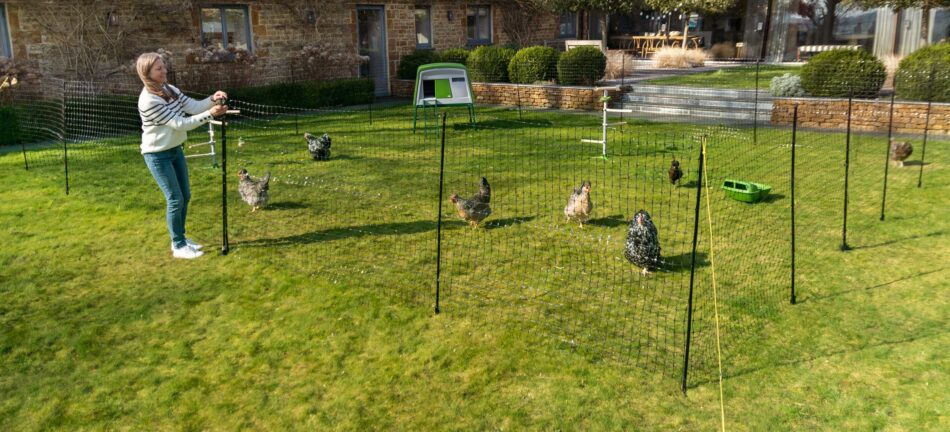
Like chicken wire, chicken fencing is also not designed to be predator-proof – rather it’s sole purpose is to expand the space your hens are in. Whilst your flock are roaming around the space given by their fence, you’ll want to keep an eye for predators as they may still be able to chew through the netting. A walk in chicken run will provide greater protection from predators if you need to take your eye off the hens.
Which lasts longer: chicken wire vs chicken fencing
As it is made from thin steel, chicken wire is prone to rust and corrosion. This means you’ll find it only lasts up to 5 years, with you needing to replace it frequently. Those who live in a wet climate, with moist soil will find it rusts quicker than those in drier climates.
As it is made from more durable materials, chicken fencing is likely to last longer than traditional chicken wire. This means you won’t find the need to replace it quite so often. The fence is also far more stiff that ensures it doesn’t tangle in the same way as chicken wire, which also helps to extend its longevity.
How many types of wire fencing are there for chickens?
Chicken wire can come in a variety of metals, but galvanized steel versions provide the best strength and durability. As with choosing between different chicken coops, you’ll want to find the perfect wire for your hens. You’ll also find that the wire comes in different diameters, choosing a higher gauge will make it more difficult for animals to gnaw through the chicken wire. You may also wish to consider the size of the hexagons the wire creates, as ones that are too large will be easier for small chicks, and predators to slip through.
Chicken fencing at Omlet
Omlet’s Chicken Fencing is the ideal choice for giving your chicks extra space in your garden. With unique benefits that make our fencing the ultimate choice, you and your hens will love your new fence!
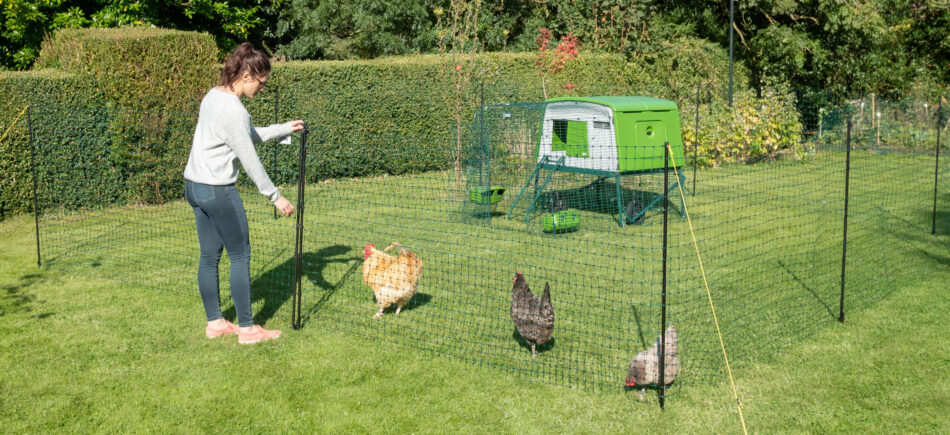
- Taller – Depending on what breed of chicken you have, they may fly a little. We’ve made our fence high enough that your hens shouldn’t be able to escape.
- Connectable – If you already have a run, or want to connect the hen fence to your garden fence, we have a wall connection kit that will help you attach the two with ease.
- Blends into the garden– Our improved fencing comes in black that blends seamlessly into your outdoor space.
- Easy to install – Tangle-proof netting, with adjustable poles makes our fence super easy to install. Each pole comes with two spikes for stability that can be trod into the ground easily.
- Reflective – Safety is important in any outdoor space. Our chicken fencing has high-vis guy ropes, as well as reflective badges on the fence itself so you can spot it at night.
- Gate for easy use – For those wanting to get in and out of the pen to see their hens, our fencing comes with a simple gate system so you can have access to your chicks.
Petcare from Omlet
For keen chicken keepers, we have everything you need for happy hens. Customize their coop with fun chicken perches, chicken toys, and even protect them against the elements with our weather protection for coops and runs.
This entry was posted in Chickens
Omlet’s Social Media Executive Rosie rescued five chickens with the help of BHWT earlier this year. After a summer of settling in and enjoying the great outdoors, the hens and Rosie are now preparing for flockdown. As of Monday 7th November 2022, all poultry and captive birds in England are under mandatory housing measures to stop the spread of Avian Influenza. Learn more about the new guidelines here.
We caught up with Rosie to see what changes she has made to follow new guidelines and keep her hens happy and healthy!
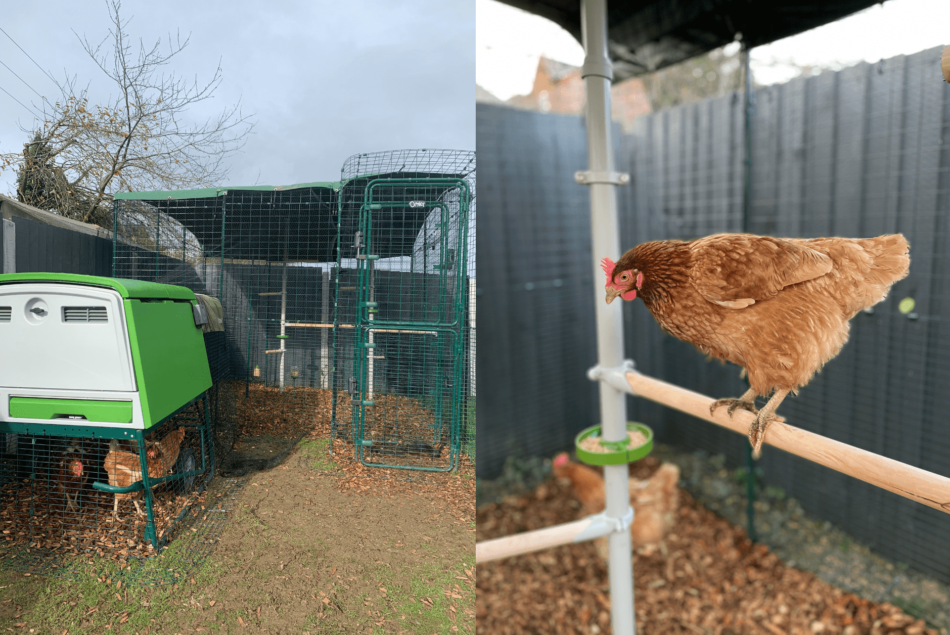
How did you feel when you heard the news?
I have been working at Omlet for a few years now, so I knew there was a risk of flockdown this year as well, but it still caught me by surprise when I read the news.
My hens have spent most of their lives locked up, and it’s been really lovely to see them explore the outside world over the summer. I can’t lie, I do feel a bit disheartened having to restrict them again, but I know it’s for the best. Hopefully the sooner we take action the sooner they can be let out again!
What does the new guidance mean for your chickens?
Obviously the biggest thing that is going to change is that I won’t be able to let the hens out in the garden during the day.
Luckily I already have a large Walk in Chicken Run, but smaller wild birds could potentially get through the mesh, so we’ve had to double up on protection. We’ve had large covers on the roof since we got the run and now, down the side, we’ve put some thinner fruit netting. That way wild birds can’t get in, but the hens get plenty of ventilation and natural light. It doesn’t look picture perfect at the moment, but at least it keeps them safe.
We had actually already ordered some new wood chippings for the run floor in time for wetter weather, so we’ve spread that in the run to avoid mud and damp.
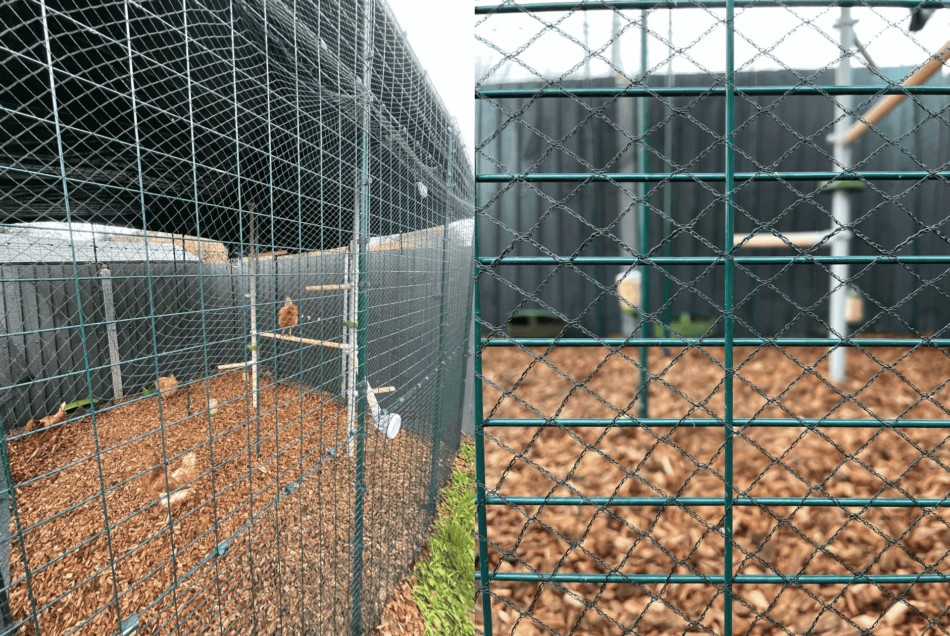
Cleaning and disinfecting is another big part of the Defra advice, are you making any changes there?
I deep clean the coop once a week, but I think I will be a bit more vigilant now and properly disinfect anything that comes into contact with the hens and their food. Stuff like brushes, food scoops and the feeders and drinkers, which normally I just have lying around.
I’ve also put some wellies on the run porch that I only wear when going into the flock. There’s also a bucket with water and disinfectant which I dip the boots into before going in so I know I’m not bringing anything nasty to the chickens.
Similarly, I do regular health checks on all the chickens, but I will probably keep an extra close eye on them now.
How are you going to keep the hens entertained while they are in the walk-in run?
I’m sure they will be okay in the run, they’ve got each other, quite a lot of fun stuff to scratch, and a PoleTree chicken perch to climb and perch on. But one of the tips I was given was to rotate the entertainment regularly so that there’s something new for them to explore every, or every other, day. So I might give them some pecker balls in the Caddi one day, then some corn in their Peck Toys another, and then on the next day I’ll move the perches around a bit on their PoleTree. Hopefully they’ll appreciate having something a bit different each day!
What’s your top advice for worried chicken keepers?
- Cover the run to stop wild birds and rodents
- Disinfect everything that comes in contact with the flock, including your shoes
- Provide lots of hentertainment to keep the hens stimulated, like treat holders and perching solutions
- Keep yourself updated with news from Defra (you can register with APHA here)
We’ve asked our friends at BHWT for some advice. Their founder Jane Howorth MBE said:
“It can be a challenging time for pet hen keepers who want to see their beloved pets outside free ranging, just as we want to continue rehoming as many ex-commercial hens as possible. However, the impending housing order has been put in place to protect all birds and, in fact, it is possible to make flockdown a positive and enjoyable experience for your hens.
Now’s the time to get creative with boredom busters such as pecking blocks and treats – though don’t overdo it as these can be very fattening! Creating extra perches is a simple way to increase their exercise, as is hanging up coloured string for them to peck at. Dust baths remain important and the benefit of having them in a covered run is they won’t get boggy from the wet and wintry elements.
We’ve got lots more ideas for boredom busters on our website, and our Hen Helpline is available for anyone concerned about their hens’ health during the flockdown, or anytime at all.”
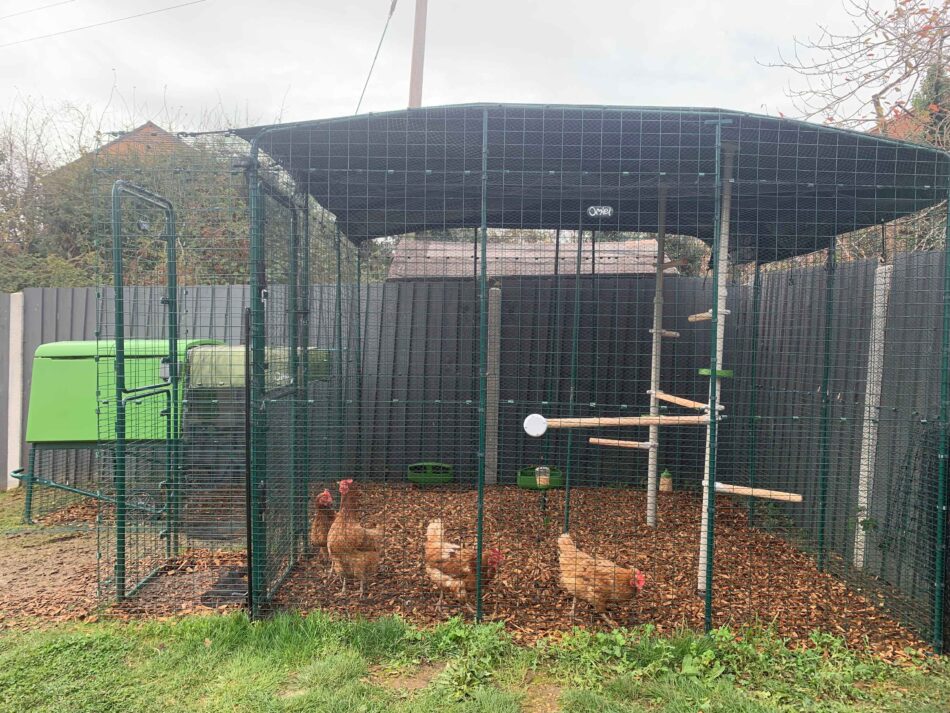
This entry was posted in Chickens
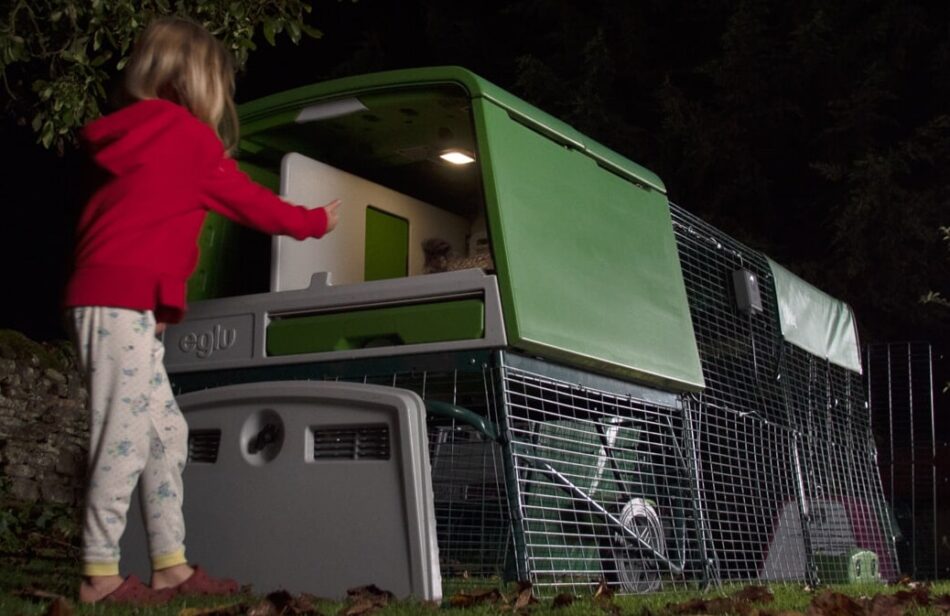
Remember, remember the 5th of November! As we approach the highly anticipated Bonfire Night with excitement, many of our pets don’t, including our feathered friends. And since we can’t speak fluent ‘chicken’ to reassure our birds, fireworks can be a confusing and scary time for some. But, this doesn’t mean you can’t help your flock get through this explosive occasion safely and as stress-free as possible! After some tips? Let us fire away…
A chicken’s eye view
But first of all, why exactly is it that some chickens don’t like fireworks? Well, since chickens are prey animals, they’re often skittish and sensitive by nature, and on the lookout for danger. Whilst this is usually in the form of a pesky predator, the loud and sudden bright lights, bangs, crackles, and whistles of fireworks can also spook our chooks.
Are my chickens stressed?
When it comes to chickens and stress, it can stem from all types of different factors such as inadequate nutrition, physical stress, and an overcrowded coop to name a few. You’ll notice stress signals such as stopping laying eggs, feather pecking, feather loss outside moulting season) egg eating, and lethargy over an extended period of a stressful time.
Ever experienced a ‘fight or flight’ reaction? With fireworks, chickens can experience something similar, with temporary sudden noises such as a neighbour’s dog barking also triggering the first stage of stress AKA the alarm stage. Whilst some chickens won’t bat an eyelid (or three), at fireworks, just like us, chickens all have different personalities, and will react differently to one another. But, should you see your birds darting away, acting more skittish than usual, and fluttering their wings, they could be feeling a little stressed out. Fortunately, though, you can help make sure your flock is nice and relaxed before the main event.
Chilled chicken tunes
A spot of classical music is enough to calm any of us down on a stressful day – the same goes for chickens. In fact, hens love all types of music! A study conducted to see the effects of playing music to chickens and egg production even found a 159% increase in hens entering their nest boxes during the experiment compared to the weeks music wasn’t played! Classical tunes were a favourite for the hens, so why not try out your classical ‘Beethoven’ playlist? All you have to do is place a radio at a low level inside their coop. Even if it doesn’t mask the sound of fireworks completely, the soothing tones will support relaxing roosting.
Keep calm and try supplements
Have you ever placed lavender under your pillow at night to help you get to sleep? Lavender is a great supplement for chickens too and has the added bonus of making everything smell great! Pop some lavender in your chickens’ nesting box to use as a natural stress reliever.
A safe and secure chicken coop
You can also keep your chickens safe on Bonfire Night by making sure that they’re secured in a safe space. We know how important it is that our chickens have somewhere they can retreat to, as well as the importance of our peace of mind, too. Omlet’s Eglu Cube Chicken Coop is the perfect space for chooks to shelter the fireworks. It also goes without saying that you should ensure that the coop is well out of reach from any fireworks that are being set off. For extra security, use the manual mode on our Automatic Chicken Coop Door Opener to say goodnight to your flock before the fireworks start.

Lightproof the coop
It’s not just the loud noises that can scare chickens on Bonfire Night. The bright lights from the fireworks can also ruffle a few feathers, so cover up any windows of your chicken coop to minimise stress levels.
All ready for the big night? Read our Pets’ Guide to Surviving Fireworks Night to see how you can help out your other furry friends.
This entry was posted in Chickens
Depending on where you are in your walk of life, bedtime can be either a highly anticipated event, or a dreaded routine for humans. Thankfully, bedtime is something that comes naturally to chickens — and you can keep your flock on schedule with the Smart Autodoor independent from other human obligations. Find out how this revolutionary chicken-keeping gadget will improve your flock’s safety, and simplify your own schedule.
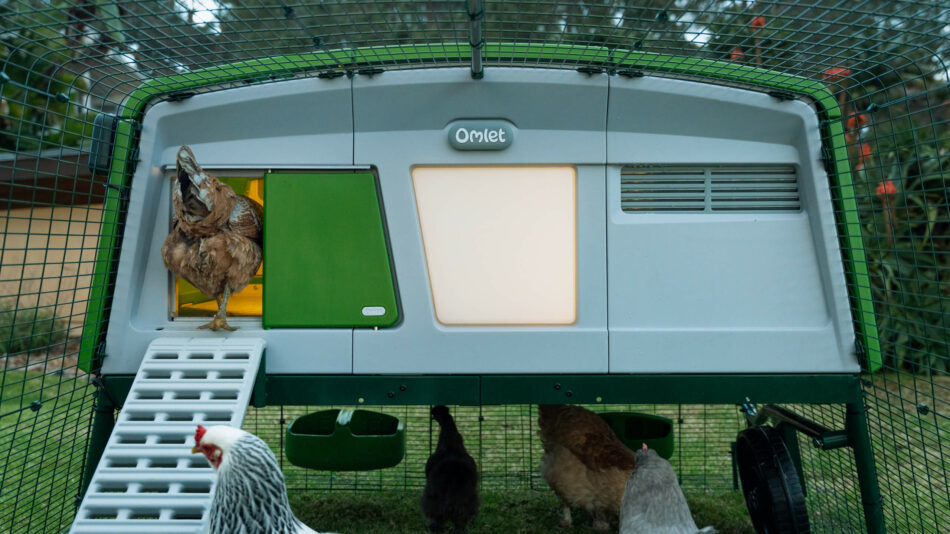
Automate your flock
Some of us are early risers, while others take gentle coaxing and lots of caffeine to tackle the day ahead. Chickens fall into the first category. In fact, if chickens don’t get their early start, they’re likely to raise an almighty ruckus to convey their displeasure.
Whether you let your flock free-range or keep them close to home in a walk in chicken run or with chicken fencing, your hens will always be safest when tucked into their chicken coops overnight. But what happens when you take a trip, or get sick? Or get home after dark, or simply forget? All of these events don’t have to throw your flock off schedule. Enter: the Smart Autodoor.
Imagine laid-back mornings where your leading ladies can strut right out of their coop at dawn while you enjoy sleeping in. Then when night falls, they can put themselves to bed where they’re securely sealed in their coops without the help of their humans? If only human children were this easy.
Working with your chickens’ schedule
Nature has provided chickens with their own built-in clock that prompts them to seek the safety of a roost when night begins to fall. You’ll notice your hens enter their coop when dusk descends, settling onto their roosting surface with their feather skirts draped over their feet. But some chickens may dawdle in the dwindling daylight in search of the last few insects of the evening. The Smart Autodoor helps encourage even the most free spirited hens to head to bed.
The Smart Autodoor has its own sophisticated settings to accommodate your flock’s schedule. The intuitive daylight sensors located on the control panel enable the door to be programmed to open and close at the desired daylight levels to keep with your hen’s regular routine. This setting can be adjusted through our user-friendly app, or manually on the control panel itself.
Coax your chickens to safety on a schedule
Chickens aren’t the only animals that take their cues from the sun. The majority of predators come out at dusk and stay active until dawn. Depending on where you live, you may need to usher your flock to safety before dusk and keep them secured in their coop an hour or two after dawn to avoid nature’s equivalent of predator rush hour.
The Smart Autodoor’s manual time setting can be adjusted through the app or control panel to set the schedule of your choosing. Simply set the open and close times for instant poultry protection around the clock. This method may require some training on your part to help your hens adjust to this type of schedule, so come prepared with chicken treats or spend a few days putting your hens in the coop right before the door is scheduled to close to help them acclimate to their new schedule.
For the “freebirds”
Not everyone loves a schedule. If your flock has adopted a free-range, do-as-they-please lifestyle, they may not find the idea of structured bedtime appealing. That’s why the Smart Autodoor has a manual setting for the door to be opened and closed whenever it’s most convenient for you and your flock.
The WiFi connected Smart Autodoor can be controlled via the mobile app anywhere in the world. You can also sync the Smart Autodoor with your Alexa or Google Home device for a virtual coop-concierge to open and close the coop door. Through the app, you’ll be able to see if the door is currently open or closed, and manually control the door to secure your free-spirits whenever they decide to head to the roost.
Give your flock a night light
Like children, chickens are wary of the dark. When you’re pint-sized poultry, it’s easy to be scared of things that go bump in the night — and for your flock, many of those threats are real. Our coop light integrates with Smart Autodoor to act as a soft beacon to beckon your hens to bed.
The coop light has a default setting to come on 5 minutes before the Smart Autodoor is scheduled to close. This setting can be configured in the app for customized light settings. Your coop light will automatically turn off a few minutes after the door closes, enforcing a respectable “lights out” time. The coop light can also be turned on and off manually, making late night coop checks a breeze.
Other benefits
Along with the changing of the seasons comes time changes and schedule shifts for your flock. These changes usually occur slowly, but some areas experience fast weather shifts and short transition periods. That means it’s never too late, or too early, to begin preparing your flock for the next season ahead.
The Smart Autodoor keeps your flock on schedule based on the sun or the clock, but also offers additional protection against predators insulation against the cold. The horizontally opening mechanism is nearly impossible for predators to pry open, and the secure seal makes cold drafts through an open coop door a thing of the past.
Omlet and your flock
When questions arise, Omlet answers with tangible, functional solutions. The Smart Autodoor answers the question of: what if chicken keepers could automate their flock from anywhere in the world? And when combined with an integrated coop light, your flock will never miss roost time. Add a Smart Autodoor to our safe, insulated chicken coops for year-round comfort, protection, and convenience for you and your flock.
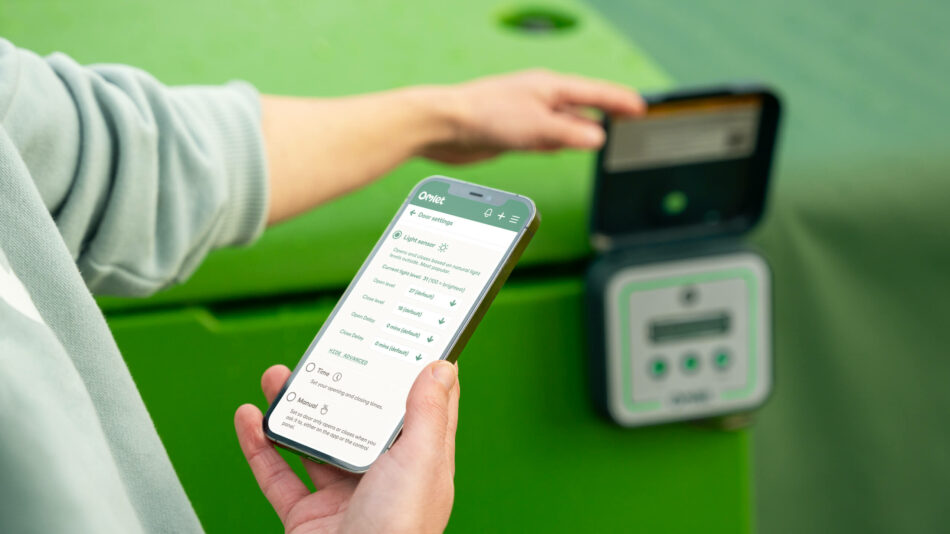

This entry was posted in Chickens
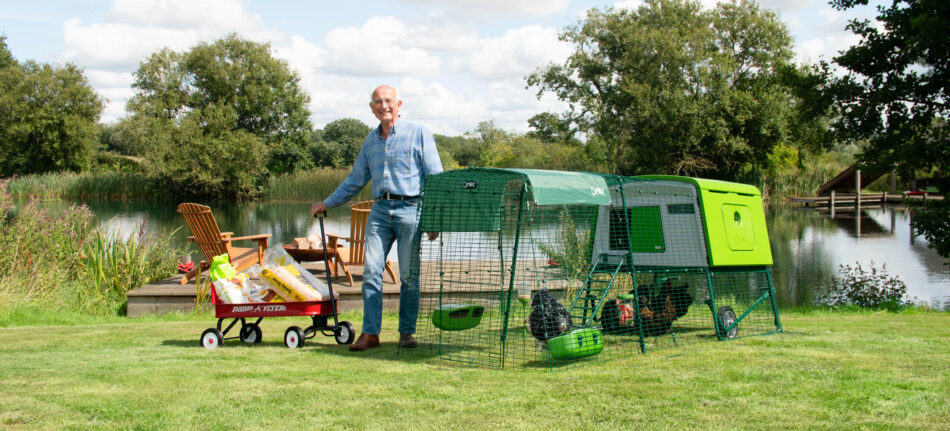
The Omlet Eglu Cube Chicken Coop helps make your chicken keeping lifestyle simple and fun! The double insulated walls ensure your chickens are always warm in the winter and cool in the summer, and the easy to clean surfaces make maintenance a breeze! But perhaps one of the best features that the Eglu Cube offers is its versatility!
Designed to fit flocks of all sizes, the Eglu Cube is the perfect coop for both the novice and seasoned chicken keepers alike. And if you are looking to create more space with your existing Cube, we’ve got everything you need to know!
Do my chickens need more space?
Whether you have 2 or 10 hens, you want your chickens to enjoy as much free range space as possible. Chickens aren’t that much different from us when it comes to space, and the more places we can explore, the happier we are! And the same is true for chickens! And we all know that happy hens = yummy eggs!
The Eglu Cube is the perfect hen house for all chicken keepers as it can house a wide variety of flocks:
- Up to 10 bantams OR
- 8 medium size hens OR
- 6 large breed hens
While the Cube itself is a perfect size space, allowing for even more room to roam is super beneficial to your feathered friends! Why? Because chickens like to have “personal space” just as much as any other animal! And at Omlet, who are we to stand in the way of a chicken and their space?
Versatility of Eglu Cube vs. traditional wooden coop
Our product designers carefully constructed the Cube with very unique features that allow for an easy housing system for both you and your hens! We know chickens and our mission with our designs is simple – provide a safe and easy to manage product that brings you and your animals closer and happier together.
So let’s take a look at just how versatile the Eglu Cube really is! We created the rear door panel to give you seamless access to the inside where you will find everything that you and your chickens will need. The separate nesting box creates a private space for the hens to feel comfortable and safe and also allows for chicken “alone time”.
Unlike traditional wooden coops that need to be painted and treated regularly, the Eglu Cube is completely maintenance free! A quick spray down with the hose to clean the messes and you will start to wonder why you haven’t been chicken keeping longer.
Walk In Runs and extensions
Are you looking to expand your flock? Or perhaps just add more space for your existing chickens to peck and play? Either way, we are here to help. Thanks to the modular and versatile design of the Eglu Cube, you can very simply create a henertaining playground for your chickens!
Walk In Chicken Run: The Omlet Walk In Run is truly customizable to fit any flock! Made from a strong and sturdy steel mesh, you can confidently place the Eglu Cube in the Walk In and let your chickens roam free without worry of any predator intrusion. The Walk In Run also provides a perfect way for you to actively engage with your feathered friends! Yes, even your 6ft tall friend can comfortably hug your hen as the run is designed for chickens – and humans! – of all sizes!
Chicken Run Extensions: Need even more space? No problem! The Omlet Chicken extensions were designed for exactly that purpose! With options of 3ft or 6ft widths and 3ft to 24ft lengths, you can literally customize your run to your specific needs. But what about when it rains? No need to worry! We have you, and your chickens, covered with the weather protection run covers! Rain or shine, your chickens will be just fine in the Walk In Run and Extensions!
Autodoor
The advancement of technology has made life easier for us, as well as our animals! And chickens are no exception. If you’re looking for the safest and most convenient way to let your chickens in and out of the coop, look no further than the Omlet Automatic Chicken Coop Door – the best hands-free chicken door on the market!
Chicken keepers everywhere love this door for its ease of operation and the added security it provides. Designed to fit both the Eglu Cube as well as a traditional wooden coop, the Autodoor can be operated by a light sensor or a timer. No longer do you have to jump out of bed in the morning or rush home at night to manually handle the coop door! Enjoy your life more freely knowing that your flock is perfectly safe with the Autodoor feature!
Wheels
A chicken coop on wheels? What more could any hen ask for?! By adding wheels to your Cube, you are able to find the perfect pecking spot in your garden by moving your hen house anywhere!
And when the temperatures start to get colder, simply move the Cube closer to your house! Not only will your hens get the extra protection from your dwelling, but you also won’t have to walk too far in the cold to check on your chickens.
We know that you have many options when it comes to choosing a coop home for your chickens. That’s why we created the Eglu Cube to be everything a chicken keeper on any level could ever want or need. And with all of the extra accessories and options, your garden beckons to be a spacious playground for your feathered friends!
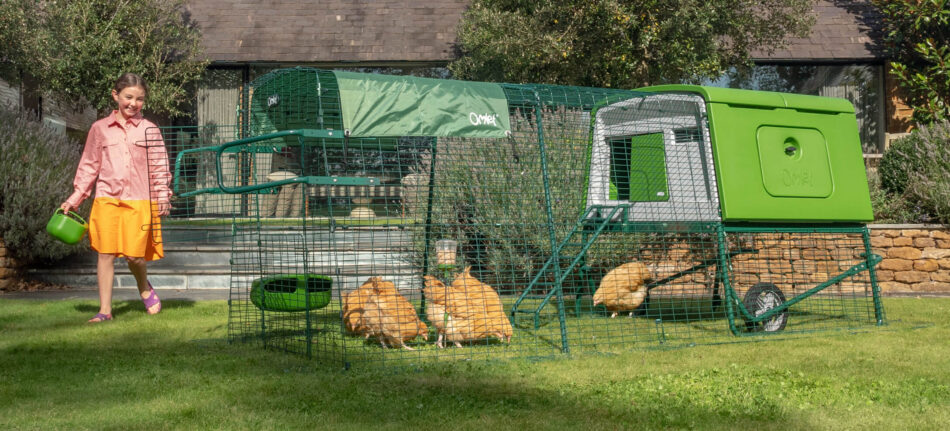
This entry was posted in Chickens
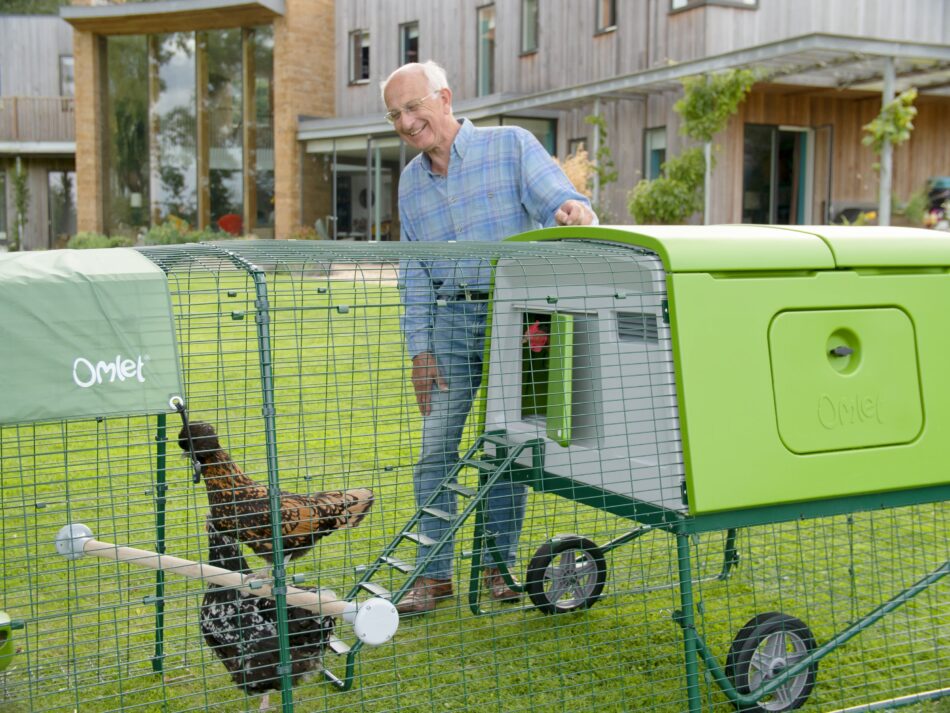
What’s there not to love about a little autumnal getaway from the hustle and bustle of daily life? Long walks in the countryside with the crunching of crisp leaves beneath your feet, or maybe for you it’s endless hours inside relaxing and avoiding the elements and enjoying the sound of chirping birds from the comfort of a cosy cottage. Speaking of…what about the chickens at home?!
If you didn’t make it on a summer holiday this year, you may have never experienced being away from your feathered friends for more than a few hours. So, what exactly do you do when you’ve made the decision to leave your chickens?
What is a chicken sitter?
Babysitters, dog sitters, and even cat sitters are terms we’re all familiar with, but what about a chicken sitter? Just as you would when leaving beloved fido for a few days, a chicken sitter is a trusted individual or group that can take care of your chickens in your absence. This might be a friend, neighbour, family member, or even someone from a reputable, trusted chicken sitter directory.
How long can chickens be left alone for?
Leaving your flock to their own devices is a bit different to leaving another pet such as a dog or cat at home. These amazing animals are pretty self-sufficient, so can be left alone for up to 3 days before you should have to consider a chicken sitter. This being said, it won’t do your chooks any harm either, should you want someone to keep a beady eye on them even if you’re only going away for the night! Most importantly, chickens need constant access to food and water that won’t run out, and enough space in their enclosure to move around.
Whilst chickens are relatively low-maintenance, we still know just how important it is to you to make sure your feathered babies will be well looked after when you’re not there. That’s why we’ve compiled a list of these essentials that will help not only the lucky chosen chicken sitter, but also for you to feel reassured, and of course for your chooks to remain safe, comfortable, and happy during your time away, regardless of how experienced (or inexperienced!) your chicken sitter is. Now, are you ready to bid bye-bye to the girls for a few days? Here are the essentials.
The essentials
A secure chicken coop
The best way to make sure your chickens are safe is with a predator-resistant coop such as the Eglu Cube from Omlet. Thanks to the unique anti-tunnel skirt, pesky predators will be deterred from trying to break or dig through the coop, meaning that you can be assured that your hens will have the best levels of protection whilst you relax on holiday. Take a read of our How Strong Are Eglu Cube Chicken Coops? where our Eglu Cube chicken coop was really put to the test (p.s. It survived a black bear attack!).
As well as being incredibly secure, all of the Eglu chicken coops have been expertly designed to be super simple to clean. So whether your hens are in the capable hands of an eggspert chicken keeper or amateur Auntie Alice, looking after chickens has never been easier. The Eglu Cube’s smooth, wipe-clean surfaces and slide-out droppings tray mean that your chicken sitter can have your hens’ home sparkling clean in just minutes! Watch this clip to see how sensationally speedy Cube coop cleaning can be.
Hentertainment
It’s key to make sure that your chickens stay hentertained whether you’re there or not. Having bored chickens can lead to unwanted behaviour such as egg eating, so it’s important to keep their brains mentally stimulated. And just as with other pets, you can encourage this through play. Make sure that your hens have an unrivalled garden setup before your travels, which can be created using toys such as the Caddi Treat Holder and Pendant Peck Toy, which can easily be refilled by your chicken sitter. Not only do chicken toys provide chooks with hours of entertainment, but also help to improve coop hygiene by keeping food off the ground – even less cleaning for your chickens’ provisional parent!
Poultry playground essentials
Another great addition for your hens before you go is the PoleTree Customisable Chicken Perch. Choose the perfect perch kit for your flock, assemble it in a few simple steps, and your chickens will do the rest! It’s a great opportunity for your chickens to show off their impressive perching skills to their sitter too!
If you’re happy to keep your chickens free ranging with your chicken sitter, the Freestanding Chicken Perch will suit your poultry playground perfectly. Just like the Poletree Chicken Perch, the Freestanding Chicken Perch is completely customisable, so will keep your chickens hentertained, with the perches adjusted to their abilities and needs. Don’t forget to set up your perch before heading off, and give your hens the chance to get used to their new accessory.
An automatic chicken coop door
An automatic chicken coop door is next on our chicken sitter essentials list. This is a must-have if you want to ensure your hens’ routine remains the same whilst you’re away. Omlet’s Autodoor allows users to choose from 3 unique settings to fit their lifestyles. Opt for the light setting and your Autodoor can be automated to close at dusk and open at dawn. The time setting means that you can choose an exact time for the door to open and close, whilst the manual setting gives chicken keepers the option to control the door however they wish.
This makes the Autodoor perfect for when leaving your chickens with a sitter, knowing that you can still remain in control of bantam bedtime. What’s more, the Autodoor has built-in safety sensors, meaning that you needn’t worry about any feathery obstructions getting trapped.
If you haven’t quite got your hands on an Eglu chicken coop just yet, then the Autodoor can still be attached to any wooden chicken coop, maximising the security of your chickens’ enclosure whilst you’re on holiday.
The ultimate thank you gift!
You’ve made it a week away from your chickens! No doubt, you’ve missed your flock tremendously but know that they have been left in capable hands following our chicken sitter essentials guide! By now, your chicken sitter is already convinced to get a few of their own (if they haven’t already!), but it’s also time to say thanks with the ultimate thank you gift, and what better than a kitchen accessory to store the delicious eggs your hens have been laying all week.
Omlet’s Egg Skelter is a great choice, coming in 3 colours to fit the design of any home. It’s also an eggcellent way of keeping hens’ eggs in date order, to ensure optimum freshness. Alternatively, go for the Egg Ramp as the ultimate chicken sitter thank you gift. The bold design stores up to 12 eggs and conveniently keeps them at room temperature.
Leaving any pet behind isn’t easier, regardless of how long you decide to go away for. Most importantly, is that you are confident in who you have decided to leave your chickens with, But with these chicken sitter essentials, it will mean happy holidays for you and as less stress as possible for your chooks!
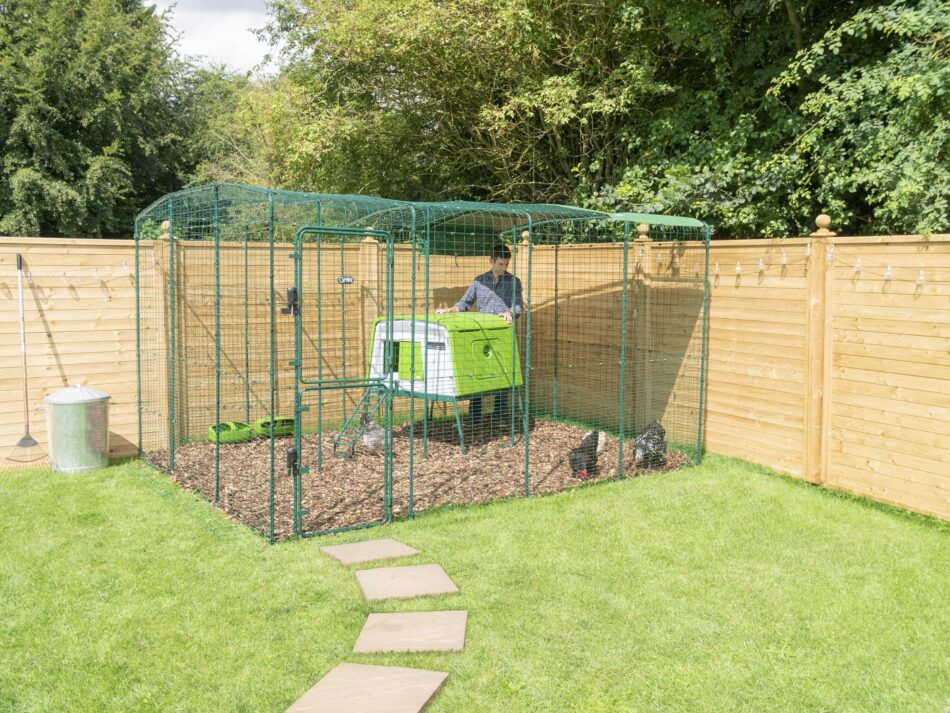
This entry was posted in Chickens
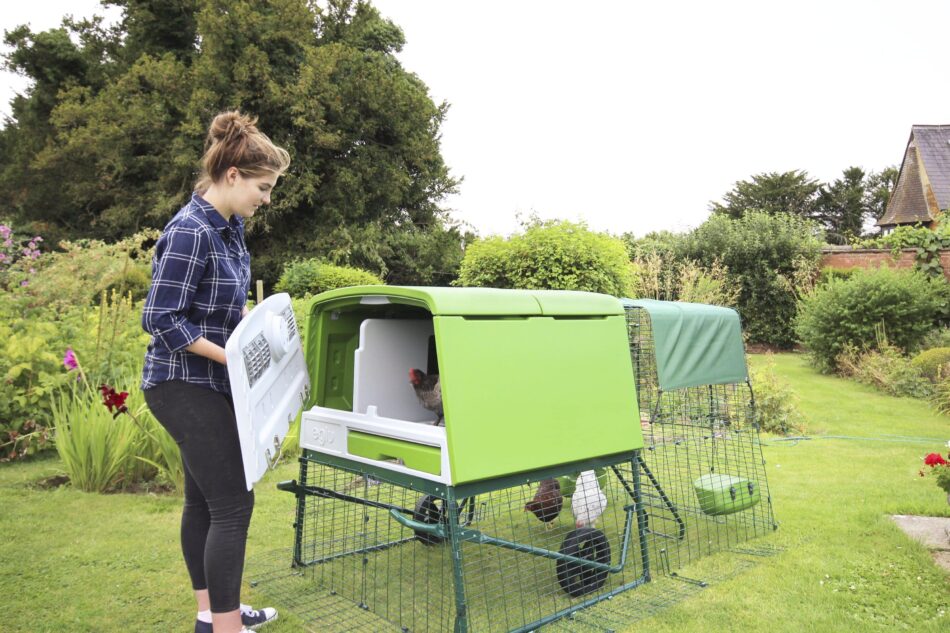
A quick search on the internet will provide a plethora of chicken coop options to purchase. But not all coops are created the same! At Omlet, our product designers know that keeping chickens is fun and simple, which is exactly why they created the easy to assemble and quick to clean Eglu Cube Chicken Coop.
Why you need an Eglu Cube
While wooden chicken coops have traditionally been used to house hens, there are better options available! Before you go buying a mini-house lookalike, take a read over all the reasons the plastic Eglu Cube is the best option:
- The material your coop is made of matters! The Omlet Eglu Cube is made of hard, durable plastic making it resistant to termites and parasites. Unlike a traditional wooden coop that needs to be treated, painted, and reroofed regularly, the Eglu Cube doesn’t require any of that maintenance – think of all the time and money you will save!
- The easiest to clean coop on the market! The product designers made this coop with clean-up in mind so all of the surfaces are easy to wipe down in minutes. No more need to worry about smelly chicken coops! In fact, all of the Eglu parts are easy to remove and even pressure wash clean if needed. Your hens will thank you for a sparkly clean and hygienically healthy home!
- It’s a weatherproof wonder! Chicken keepers from Florida to Fargo can attest to the outstanding weather performance of the Eglu Cube! Carefully designed with a unique double-wall insulation system, the Eglu allows your chickens to stay warm in the winter and cool in the summer. When tested against a traditional wooden coop in the cold winter of Germany, we concluded that a winter ready chicken coop like the Cube can make all the difference between a cosy night’s sleep and one spent shivering to keep warm!
Hassle-free Cube = hassle-free chicken keeping
Some people may object to keeping chickens for reasons that include smell, time commitment, and space. But the reality is that these are all just chicken myths, and with the right products and preparations, chickens are low-maintenance pets. The Eglu Cube from Omlet helps to make that job easier!
SMELL
So you think chickens in your backyard might create a bad smell? Well, the truth is, chickens are actually clean animals. The smell that many are afraid of isn’t from the chickens themselves, but rather from the chicken droppings. But, with the easy to clean Eglu Cube, you can spray down your coop in minutes and avoid any unpleasant odours.
TIME
Like any animal, owning chickens requires a time commitment! Just like cats and dogs, they need daily food and water and physical and mental stimulation. Other than that, they are self-sufficient animals! Investing in the Eglu Cube allows you to save even more on time with its easy assembly! We had the novice chicken-keeper in mind when designing this coop, so we created a product that is super easy to put together. In fact, you just need one tool to get started!
SPACE
Probably one of the biggest myths in owning chickens is that you need to have a huge backyard to house your hens! For the average chicken-keeper, a regular sized backyard will do just fine! The great thing about the Eglu Cube is that you can opt to add wheels to the coop allowing for it to be movable by one person to another location. What chicken wouldn’t like a house on wheels?
Step-by-step guide
Choosing the right chicken coop can be the hardest part of chicken keeping. So now that you have decided on the Omlet Eglu Cube, let’s take a look at the 7 simple steps to assemble your hen’s new house!
- STEP 1: Grab a screwdriver and a friend. Yes, that’s all you need to put together this super easy to assemble coop! All of the materials are included in the boxes upon arrival, so you simply need to lay everything out to get started. If you want, you can even watch this tutorial video to follow along each step!
- STEP 2: Now it’s time to construct the frame! With the help of a friend, follow the detailed step-by-step instruction manual to build your coop base. Made from heavy duty steel, this frame is not only strong but will keep your chickens safe and secure.
- STEP 3: Now it’s time to get rolling! If you opted for the wheel accessories, this step includes their installation. The moving mechanism of the Eglu Cube wheels was created to allow for one person to move the coop with ease!
- STEP 4: Time to install the run – a chicken’s favourite part! The size of the run you buy depends on how many chickens you plan on keeping. The goal should always be to give your chickens the most space you can – either free range in the backyard or with a bigger walk-in chicken run. And if you find it hard to decide which is best for you, just contact our customer service and we will be happy to help!
- STEP 5: You’re almost there! Now it’s time to assemble the cube house and attach it to the frame! Made from 100% recyclable and UV stabilized polyethylene (super strong plastic!), you will have peace of mind knowing your chickens are in the best built hen house on the market.
- STEP 6: It’s accessory time! One of the greatest benefits of the Omlet Eglu Cube is all the optional accessories you can add to your hen house! The essential feeder and waterer bins are constructed from the same strong material as the house and designed to be just as easy to clean! You can also add the automatic chicken coop door which allows your chickens (and you!) to sleep soundly at night knowing that predators cannot get in!
- STEP 7: All that’s left to do now is add your flock! You have just built an efficient and practical home for your chickens that can stay with them for years to come.
Maintenance of your coop
While Omlet products are known for their durability, we always recommend regular maintenance on all products to ensure you will get the most out of them! The Eglu Cube is practically maintenance-free with its super easy to clean design, but there are few things you can keep your eye on when out and about with your chickens to make sure stability and security are 100%.
- If you notice any run clips not as tightly secured, it may be time to replace them.
- If you are a seasoned chicken-keeper and purchased an Eglu Cube before summer 2019, you may start to notice some wear on the previously provided friction stair strips. Consider upgrading your coop with the Eglu Cube ladder grips that not only make it easier for your chickens to walk in and out of the house, but are more durable as well!
- While the cube house is completely covered and protects your chickens from the elements, many chicken-keepers add run covers for added protection when the chickens are roaming the run.
One of the greatest gifts of chicken keeping is, of course, the benefit of wholesome, fresh eggs! But chickens can also be very henertaining! After long, you will notice you are loving your chickens just as much as your four-legged pets. So when it comes to making sure they have the best life possible, be sure you get them the best house!
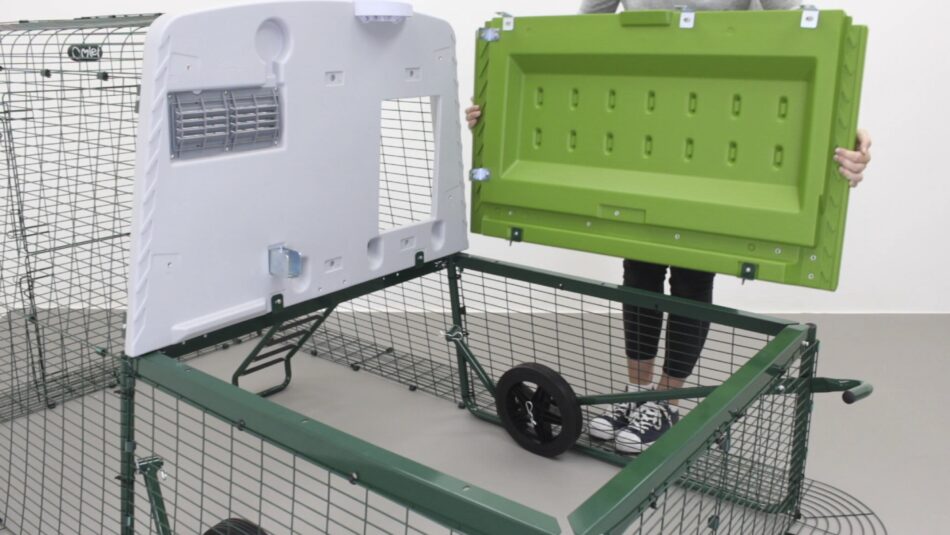
This entry was posted in Chickens
Amy Wolsey lives in Norfolk with her 11 happy hens. She’s kept busy with 6 Cream legbars and 5 Pekin Bantams. They, like her Springer Spaniel Oliver, love to help her in her garden and vegetable patch! Follow Amy on her Instagram account chicksandveg.
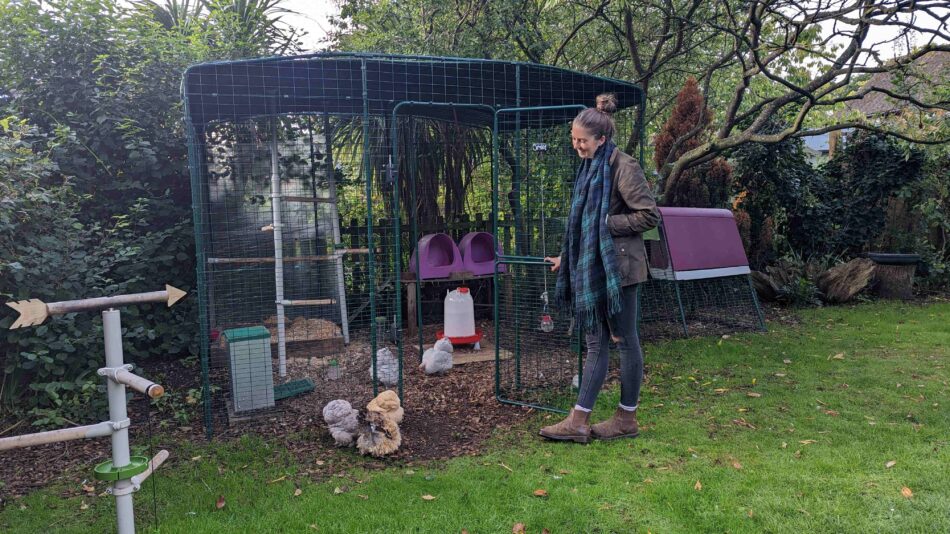
Wasn’t that a long hot summer we had in the UK? Well it certainly feels like we’re changing seasons now with the arrival of some cooler temperatures and darker evenings. Just like we dig out the jumpers from the wardrobe and crave warming soups rather than salads for lunch, it’s time to start thinking about keeping our chickens happy over autumn and into winter. Now, I’m not suggesting we wrap our chickens in cosy jumpers! But, there are some things we can do to make sure they stay healthy and comfortable in the coming months.
Health check
It’s a really good time to think about giving your chickens a general check over and looking for anything unusual. I keep an eye on my chickens all the time and look for changes in behaviour or differences in their condition but a closer look every once in a while at their feet, feather condition, head and combs is good practice. It’s also particularly important to check your hens are happy at this time of year as most go into moult. Moulting is when chickens shed any damaged or loose feathers and replace them with a fresh set. It usually happens over a few weeks and they might look a little scruffy as the new feathers grow but it’s totally normal. Growing new feathers is quite a big job and as feathers are mostly protein, I like to give my hens a boost to help them along. I add extra protein and calcium to their diets with some supplements and purchase some extra treats for them to enjoy!
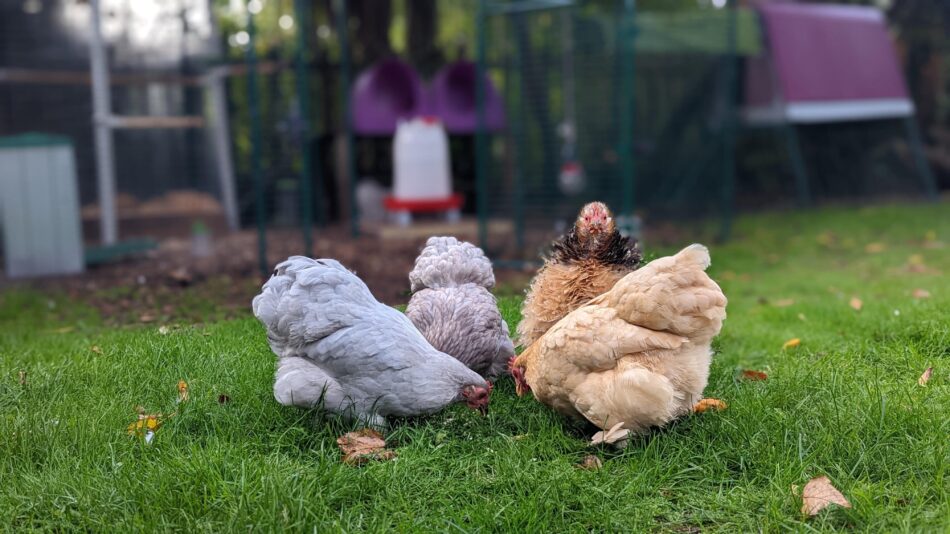
Deep clean
I regularly clean my coops but a change of season always gives me the motivation to do a thorough deep clean so everything is sparkling ready for wetter, muddier weather. With the Omlet chicken coops being plastic and so easy to keep clean, I like to give them a proper hose down before disinfecting and adding some fresh bedding. It’s also a really good chance for me to check round the runs and make sure everything is secure. I’m even thinking of adding an extension to my run later in the year so all the hens can be together so this is a good chance to plan it out!
Weather protection
Speaking of my chicken run, I’m going to add some more protection to the sides to keep things cosy over winter. I’ve got the heavy duty covers for the roof which keep it lovely and dry! It’s so important for chickens to have a dry space over winter. Lots of wet mud isn’t good for chickens and can cause all sorts of problems with their feet but also, it’s just not nice for them to move around in. Plus, chickens love a dust bath even over winter. And especially when they’re going through a moult, it’s nice for them to be able to scratch and clean those feathers! When thinking about your run, it’s also worth considering protecting the sides too and providing a bit of a wind break so the Omlet clear covers will be perfect! There’s even some cosy insulating blankets I can put over the coops in the depths of winter. The Eglus have twin walled construction so it’s not a must but with the crazy weather we’ve had this summer, who knows what to expect! Plus, any excuse to treat my hens to something new!
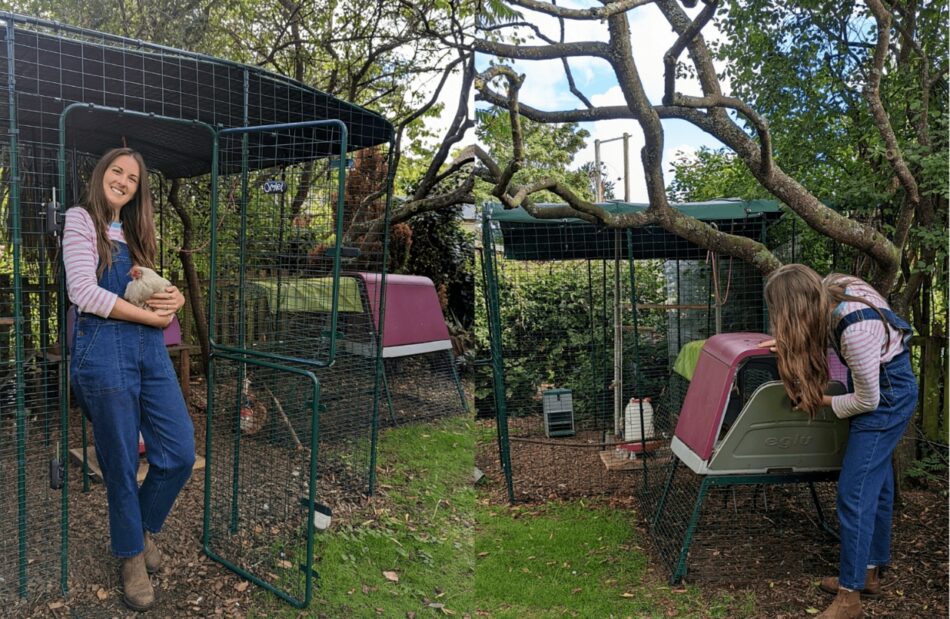
All in all, Autumn is a great excuse to give things a check over and refresh whilst keeping my hens happy, cosy and healthy! Now, where are my woolly jumpers…
This entry was posted in Chickens















































